


Women and their role in beer making over the ages







Women and their role in beer making over the ages



05 Welcome
If BEER inspires you to go to the pub, it’s done its job
15 Roger Protz
Dark beers are no longer just for the colder months – they are now sought out all year round
29 Your shout
The installation of a new tiled bar front has inspired one enthusiast to share the news
34 Learn and discover
Jeff Evans reveals how a great beer has been developed and improved over time
36 Saving pubs
Campaigners dig in for a long fight to save their local which has been operating for 400 years
48 Action stations
Campaign takes on Carlsberg Marston’s over serving keg beers through handpumps
49 Bottles and cans
Des de Moor marks CAMRA’s Members’ Weekend in Dundee with traditional Scottish treats
50 Last orders
Comedian Sam O’Leary on getting fired from pubs and why they’re bad for magicians

16
06 Alewife history
Dr Christina Wade explores the key role of women in making the world of beer what it is today
12 Famous Five
QUIZ WINNERS
For the answers to the spring quiz and details of the pleasewinners, turn to page 29
30 Black Country treasures
Bus pass in hand, Mike Clarke sets off to enjoy the best pubs and beers the region can offer
38 Sail ale trail
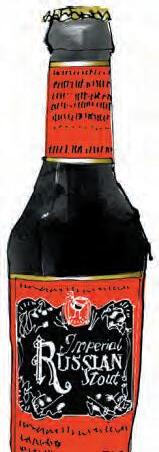





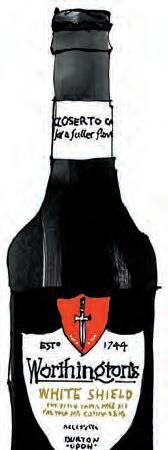
Where are the five bottleconditioned beers brewed when CAMRA was formed?
16 Family business
Roger Protz discovers the resilience needed to survive 150 years in brewing at Batemans
22 Right lines
Beer tours of South West England are not new, but Marcus Rees added a new twist by sailing between the pubs
42 Heritage
The new grading system has seen some pubs move up the ratings. We’ve covered some already and here’s another 10
46 Debate




12
Let the tram take the strain when searching out West Flanders’ best bars and beers
26 Young guardian
Jane Peyton meets the woman who has the future of some of our best-loved beers in her hands
How low will you go? Would you drink more low- and no-alcohol beers if they were more widely available on draught? Our debaters reveal all

So why not join us?
Save on beer when you visit the pub with our voucher and discount schemes. Plus save on entry to 100s of beer festivals too, just a few perks of our CAMRA membership.
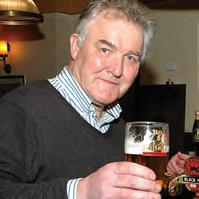
From the earliest days of brewing, women have played a pivotal role in making it, drinking it and developing beer culture.
In our lead feature, academic Dr Christina Wade, author of CAMRA’s latest book, The Devil’s in the Draught Lines, charts the role women have played in history and brings us to the modern day. She also gives examples of some of the women who are making the beer world what it is today.
From a neolithic burial site near Perth to a modern-day brewery tap, Dr Wade examines the vibrant and enduring contribution women have made to beer culture.
She says the book is very much a conversation between women past and present. So, alongside the history, she has interviewed women from across the UK about their experiences as brewers, beer writers, podcasters, brewery owners, activists and more. From all over England, Scotland and Wales, women’s presence in the brewing trade is undeniable.
l In the dedicated What’s Brewing section you will find some of the latest news from CAMRA, including an update on the campaign to save the demolished Crooked House pub, and news from the AGM and Members’ Weekend in Dundee. More news can be found on the What’s Brewing online platform at wb.camra.org.uk
Also in this issue, Jane Peyton talks to one of today’s real ale heroes, Georgina ‘George’ Young, brewing director at St Austell brewery in Cornwall. The brewing of cask ale is central to her life. Cask ale is pure and fresh and has a wonderful range of flavours that are enticing and don’t need to be masked with powerful hops and lots of fizz. I’ll certainly drink to that.
Jeff Evans explores the extraordinary story of five bottleconditioned beers brewed when CAMRA was established, and finds out what has happened to them since.
Roger Protz describes another heart-warming survival story – the story of Batemans brewery. He visits Batemans and discovers the resilience needed to survive and prosper for 150 years by brewing seriously good ales.
The world of beer is dynamic and inspiring. It is rarely static and always changing. For beer to stay the same as the best long drink in the world, it needs constant loving change. Enjoy this issue and if it inspires you to go to the pub, then it has done its job.
Editor: Tim Hampson (tim.hampson@camra.org.uk)
Sub-editors: Kim Adams and Rica Dearman
Published by: CAMRA Ltd
Produced on behalf of CAMRA by: Think, 65 Riding House Street, London W1W 7EH Tel: 020 3771 7200
Group art director: Jes Stanfield
Client engagement manager: Jack Watts
Printed by: Acorn Web, Loscoe Close, Normanton Industrial Estate, Normanton WF6 1TW.
BEER is printed on Galerie Brite Plus, which is PEFC accredited, meaning it comes from well-managed sources.
Marcus Rees takes to the sea in search of some seriously great ales


Jane Peyton travels to St Austell in Cornwall to meet our latest beer hero – Georgina Young
Mike Clark explores treasured pubs in the Black Country

BEER is the quarterly magazine of the Campaign for Real Ale (CAMRA). CAMRA campaigns for real ale, real pubs and consumer rights. It is an independent, voluntary organisation with more than 180,000 members and has been described as the most successful consumer group in Europe. BEER is available online to all CAMRA members. To receive a hard-copy version every three months, members need to opt in. Our campaigning newspaper, What’s Brewing, is now online at wb.camra.org.uk. To join CAMRA, help preserve Britain’s brewing and pub industry, get BEER and What’s Brewing updates – and a host of other membership benefits – visit camra.org.uk
Campaign For Real Ale Limited, 230 Hatfield Road, St Albans, Herts AL1 4LW Tel: 01727 867201

When you hove finished with this magazine please recycle it.
CAMRA is a company limited by guarantee, run at a national level by an elected, unpaid board of directors (the National Executive) and at regional level by its regional directors, both backed by a full-time professional staff. CAMRA promotes good-quality real ale and pubs, as well as acting as the consumer’s champion in relation to the UK and European beer and drinks industry. It aims to: 1. Protect and improve consumer rights; 2. Promote quality, choice and value for money; 3. Support the public house as a focus of community life; 4. Campaign for greater appreciation of traditional beers, ciders and perries, and the public house as part of our national heritage and culture; and 5. Seek improvements in all licensed premises and throughout the brewing industry. BEER will not carry editorial and advertising that counters these aims and we only accept advertisements for bottle- or cask-conditioned products.
Women played a major role in making the world of beer what it is today, says Christina Wade
In the valley of the River Earn, just west of Perth, sits North Mains, a Neolithic and Bronze Age archaeological site. The landscape has changed much in the ensuing millennia, with the wild expanse of trees and valley giving way to modern developments, roads and even an aircraft museum. In fact, it was when this museum expanded its runway in the late 1970s that this site came into the archaeological record. Among the finds at North Mains is a single burial of a woman. She would likely not recognise much about the world that surrounds her final resting place now, a country completely changed in almost every way from the one she called home. Except, perhaps, the beer.
You see, buried among her remains, the team of archaeologists, led by Gordon Barkley, found a vessel containing residue from a grain-based
beverage flavoured with meadowsweet; perhaps it was even a kind of ale. But what does that tell us about the woman whose grave it was found in?
Merryn Dineley is an archaeologist and expert in the study of beer and brewing. Alongside her husband Graham, a brewer, she researches, writes about and recreates ancient brews. I spoke to her about her work on these prehistoric ales and the women who might have brewed them. Merryn has examined the North Mains site and, particularly, analysed this female burial. She concluded that there was possibly a connection between the woman in the grave and brewing.
“Maybe her role was similar to that of a cupbearer, the food vessel being used to dispense the ale on festive occasions. Or maybe she was an important woman in the community who was buried with


‘One of the most pervasive myths, I think, in the UK history of beer, is that women only joined the brewing world recently’
her pot of ale. It’s not clear whether she had anything to do with actually making the malt or the ale, but I think it’s a possibility.”
A possibility indeed. Merryn told me of another similar grave from the same period at Achavanich, Caithness, Scotland, which was excavated in 1987. Here, she told me, meadowsweet and St John’s wort were found alongside cereal fragments in yet another beaker or food vessel. Of this burial, she said: “I have wondered whether she was buried with the tools of her trade. She was a maltster and a brewster.”

The Achavanich burial is not without some controversy, however, as recent interpretations have jettisoned the alcohol interpretation, instead arguing for medicinal purposes. Merryn, however, noted that “both of these plants require alcohol in order to be effective as medicine; I think this proves the contents were ale rather than disproves it”.
But regardless of the precise interpretations of these specific burials, there is much still to be discovered about women and brewing in prehistory. These burials, Merryn told me, “begin to tell a story of the relationship between Bronze Age women and ale. It is a complicated one. Were they maltsters, brewsters, cupbearers or high status women within the community?”
One of the most pervasive myths, I think, in the UK history of beer, is that women only joined the brewing world in recent years. Or, perhaps one that has more recently taken hold, that women brewed only for a short period in the medieval era before being forced out by men. However, these Bronze Age
burials hint that women might have been central to the creation of ale for millennia before the medieval period. And, in the thousands of years since these Bronze Age burials, the story of beer would not be complete without the women who brewed, served and sold it. The historian Max Nelson, in his The Barbarian’s Beverage: A History of Beer in Ancient Europe, noted the legendary Boudica and her tribe, the Iceni, were apparently quite famous for their rejection of the Roman preference for wine. Something he argued might have solidified their preference for ale.
However, the Roman soldiers in Britain, too, would consume ale, and apparently quite a bit of it. In 1973, at the Vindolanda fort in northern England, archaeologists led by Robin Birley discovered wooden tablets that detailed the daily lives of those at the fort. Among these hundreds of tablets are hints of brewing history, one written by the decurion Masculus to the prefect Flavius Cerialis requested more ale for the troops. Perhaps while writing such an appeal Masculus envisioned Ceres, the Roman goddess of grain, whose name has been invoked over the centuries alongside ale, including a famous Danish brewery founded in 1856 bearing her name that remained in business all the way to 2008.
Subsequent invasions continued to solidify women’s position in the brewing trade. When the Vikings arrived in the eighth century, they too would bring with them their gods and their ales. And like their early medieval English counterparts, women brewed. In The Saga of Half and his Heroes, a king called Alrek hosted a brewing competition between his two wives, Geirhild and Signý, with the winner being the one who would remain married to him. What a prize.
In both cultures, women importantly took up the position of cupbearer, harkening back to our Bronze Age

‘King Alrek hosted a brewing competition between his two wives, with the winner being the one who would remain married to him. What a prize’
burial. Even Beowulf offers us glimpses into the important role women played in feasting as ale servers. This role was not only a practical one but, for the daughter or wife of a wealthy and powerful man, it also played an incredibly politically significant role, as Michael Enright in his book Lady with a Mead Cup: Ritual, Prophecy and Lordship in the European Warband from La Tene to the Viking Age, argued. In fact, Enright contended that female cupbearers established the leader’s right to rule by serving him first and acknowledging his exploits.
In the old English epic poem, Beowulf tells the story of the titular character, a hero of the Goths, a North Germanic tribe. It delighted readers with his
exploits in helping Hrothgar, the king of the Danes who had been under attack by the monster Grendel, and later Grendel’s mother. But it is Hrothgar’s wife, Wealhþeow, and her daughter called Freawaru, who are most important for our purposes. After all, in the story, both mother and daughter make their rounds around the hall, serving Hrothgar’s warriors, “pouring ale”.
Like the Romans before them, the Normans’ arrival in 1066 brought with them their utter obsession with wine. But even this could not quite shake the hold that ale and ale brewing had on the island, and as we can see from sources at the time, the Normans also had a penchant for ale drinking. And as before, women were central to its creation.
The Treatise by Walter de Bibbesworth, written in Norman French sometime in the 13th century, was composed for Dionisie de Munchensi to help teach


her children French. Included within its many sections is probably just about the only example written down on how to brew in this period, which in the words of beer historian Martyn Cornell is “a reflection of the universality of ale and the universality of the knowledge of how to brew”.
However, this book was for children, and like in modern-day language schools, it included everyday things that they were to know and be familiar with, words and phrases that they would use. Which, naturally, would include brewing. Now, of course, the children to whom this book was read were of high status, likely not the people brewing themselves. But especially for the
‘In one story, Sir Glutton vows to go to church renouncing his sinful ways. However, it’s on his way that he becomes distracted by Betty the Brewster’
daughter Joan, it would be part of her daily responsibilities as a wife and household manager to supervise the process in her own estate and to also be familiar with what the role of the brewer was. And importantly, in The Treatise, the brewer was undoubtedly female. The word Bibbesworth uses is bresceresce, which is the Norman French for brewing woman. It is implicitly gendered. So once again, it is the women who are brewing. And it is the world of Bibbesworth and Dionisie that my new book with CAMRA, The Devil’s in the Draught Lines, begins. We are entranced with the history of medieval Europe. For centuries, we have been telling tales of knights and castles and ladies in towers. More recently, however, we have become fascinated with the lived reality of the common people, with books on labourers, craftsmen and, perhaps most importantly, alewives coming to the forefront. Often cited in these writings are late medieval or early modern sources depicting brewing women getting up to no good, cheating their customers and flaunting regulations.
“Good ale have I, gossip; Sir Glutton, assay it!”
In the 14th-century, William Langland wrote Piers Plowman, a lively poem which featured in its verses many tales of ale. In one story, the aptly named Sir Glutton vows to go to church renouncing his sinful ways. However, it’s on his way to the kirk that he becomes instantly distracted as Betty the Brewster beckons him into her establishment promising him good ale, but also, importantly, good gossip. In a story that directly mirrors Langland’s The Prologue to the Tale of Beryn, a 15thcentury sometimes addition to Chaucer’s Canterbury Tales, also talks about women who brew or sell ale.
‘We relish the stories of these women who brewed, often creating fantastical tales of those who defied authority and failed’
In this story we have Kit, a tapester at an inn that the Pardoner stops at on his way on pilgrimage. Here, as with Betty the Brewster, Kit tries to lure the Pardoner into breaking his fast and consuming alcoholic beverages.
We relish the stories of these women who brewed, often creating fantastical tales of those who defied authority and failed. They have come to represent a kind of feminist figurehead in the midst of a patriarchal past. In more recent times, the medieval alewife has had a bit of renaissance, with authors seeking to expunge and rehabilitate her as a casualty of sexist writings and a misogynistic society. Articles, podcasts and even TV shows tell us stories of women who were pushed out of brewing entirely by men. Some even suggest the sinister possibility that it was through witchcraft accusations, and thus death, that these women were forced from the trade.
And it is precisely this misconception that I explore in my new book.
Contrary to what is often purported, women continued to brew for centuries, even during those dreaded witch trials. In fact, they were even encouraged to do so as part of their household duties. They brewed for their families and even commercially, selling locally to neighbours into the 20th century. The Devil’s in the Draught Lines explores just how women continued to brew and be part of the beer trade well into our modern era. We will hear stories of sex workers and titled ladies, from 17th-century women with disabilities who brewed to keep themselves out of poverty to wealthy Edwardian heiresses who inherited large commercial operations. There is never a time in
the history of UK beer that women weren’t involved.
But of course we can’t forget those women who make the brewing world what it is today. This book is very much a conversation between women past and present. And so alongside the history, I’ve interviewed women from throughout the UK about their experiences as brewers, beer writers, podcasters, brewery owners, activists and more. From all over England, Scotland and Wales, women’s presence in the brewing trade is undeniable. And in fact, it was the history that led some of the women I interviewed to fall in love with beer in the first place.
Helena Adedipe, co-founder and co-owner of Eko brewery, is one of those women. In our interview, Helena told me that she is “a big history buff”. Originally from the Congo, Helena grew up watching women drinking beer, preferring it over other drinks like wine. It was very much the norm. But it was her husband Anthony’s love of the brew that pushed her further into that direction.
This, combined with her childhood experiences, fuelled her interest to learn more: “I then started to read a lot more into the history of brewing and different civilisations, especially African and how women were so influential in brewing.” This, she told me, sent them down a path of trying to learn more about the beer industry and how it has been influenced by the past, which in turn led them to trying their hand at brewing themselves, thus creating Eko brewery.
The Devil’s in the Draught Lines also explores those women who contributed to beer and brewing but didn’t brew themselves. This is something which is also a common theme for women involved in the trade today as many work in marketing, sales, finance or as podcasters and educators.
“I moved to New York and worked at an organic baby food company, using my public health degree to do
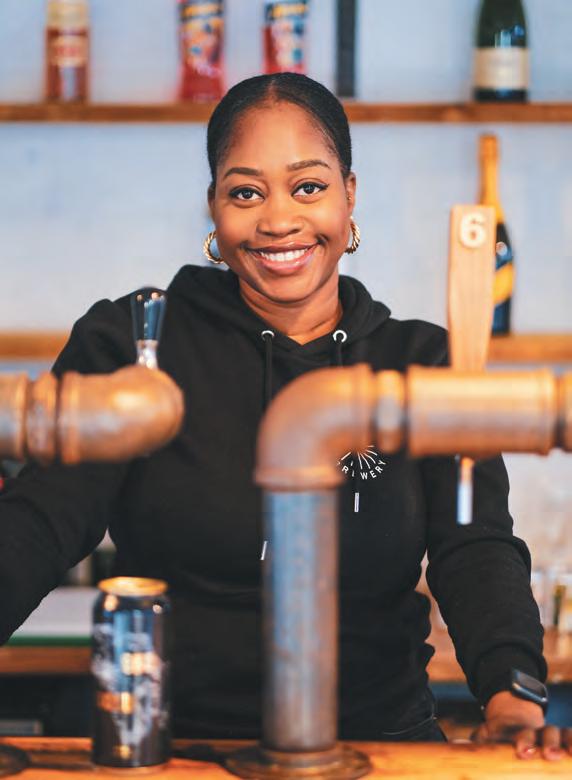
communication and marketing, with a customer service focus. But outside of work, all I could think about was beer,” Natalya Watson told me.
Natalya is a beer educator, sommelier, advanced cicerone, author and founder of Virtual Beer School. After living in the United States, she moved to London, got a job behind the bar at Mother Kelly’s in Bethnal Green before going on to work as UK marketing manager for Duvel Moortgat, a familyowned Belgian brewery.
From this, she focused on getting her beer certifications, launching her path into beer education, eventually writing Beer: Taste the Evolution in 50 Styles. The book spurred her onto founding
“I then started to read into the history of brewing and different civilisations, especially African and how women were so influential in brewing”

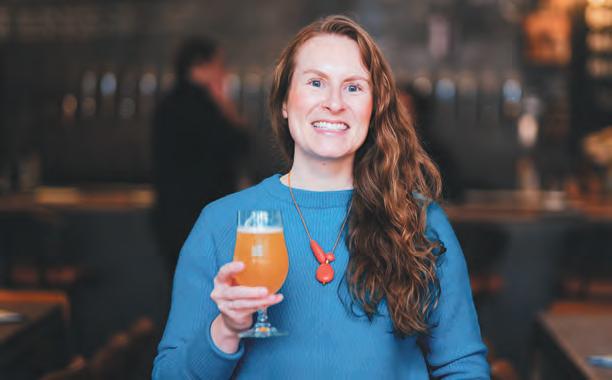
And, of course, you can start out elsewhere in a brewery before making your way to the actual brewing process. Originally from Lochwinnoch, Scotland, Lynsey Campbell got her start in the beer world, like so many of the women I spoke to, behind the bar selling pints of craft brew. From there, she started working at Fyne Ales in sales for several years, but “as time went on, I knew I wanted to be involved in production”.
After a bit of time, and some rejection, she landed a job as assistant brewer at Buxton brewery, before later working as a brewer with Whiplash in Ireland. What I think is particularly important to note is that gender was not the only thing that impacted the ways in which women experienced their lives, and as a consequence, brewing. Religion, ethnicity, race, age, ability, sexual
Virtual Beer School in the midst of the 2020 pandemic.

“Brewing is an option if you’ve grown up around it or get extremely lucky like I was. I did not understand that making beer was an occupation”
orientation, wealth and later, class, would all also have a profound influence.
Professor Kimberlé Crenshaw coined the term ‘intersectionality’ to describe the ways these confluences of identities affected people’s lived experiences. And this is a key factor in the exploration of The Devil’s in the Draught Lines, one I analyse throughout the book and something that is of great import to the women in the UK brewing world now. Women’s experiences with beer and brewing can differ greatly depending on their identities. But one thing that most women I interviewed stressed is that to get more females and others from marginalised backgrounds into brewing, you have to first establish that it’s possible.

Originally from India, Nidhi Sharma was an engineer who fell in love with brewing first, before she began to really like beer. When I spoke with her, she worked at Meantime Brewing Company as brewer, a job she is very passionate about. Nidhi stressed the importance of building a community and awareness for women inside and outside the beer trade. Events like International Women’s Collaboration Brew Day, an activity corresponding to Women’s History Month, which brings women from all over the world to brew beer together, are critical to opening up the trade to a wider audience.
Nidhi has hosted Women’s Brew Days at Meantime as a way to get beer-loving women together. None of the women who came in 2023 were brewers, she told me. “They just liked the idea of seeing the process.” Nidhi hopes continuing to do more brew days will bring more women into the wonderful world of beer.
“Brewing is an accessible option if you’ve grown up around it or get extremely lucky like I was. I did not understand that making beer was an occupation. It isn’t something that I grew up with, nor ever thought about. But now looking at my skill sets and proclivities it makes absolute sense that I was meant for this. I wish I could create some level of awareness about this industry existing as an option for women be part of.”
And so it is the hope that The Devil’s in the Draught Lines, and the stories of the women in its pages, can in some small way help to create more of this awareness of women in the brewing industry.

Dr Christina Wade is a historian and author of CAMRA’s new The Devil’s in the Draught Lines, available from CAMRA Books. RRP: £16.99/members £13.99
What has happened to the five bottle-conditioned beers brewed when CAMRA was formed in 1971? Jeff Evans investigates













In summer 2023, news that production of Worthington’s White Shield (5.6 per cent ABV) had been suspended provided a moment of reflection for lovers of bottled beers. This classic ale was one of the last five remaining bottle-conditioned beers when CAMRA was founded in 1971. Most brewers by that time had sacrificed the complexity and delicacy that a secondary fermentation in the bottle can bring in favour of the convenience and reliability of filtration and pasteurisation.
The oldest of these Famous Five beers was Courage Imperial Russian Stout (10 per cent). It dated back to the 1780s when powerful, warming stouts like this were shipped across the Baltic and found favour in the imperial Russian court. It was brewed originally by Barclay Perkins at its Anchor brewery in London and, when Barclay Perkins was swallowed up by Courage in 1955, the beer remained alive – in more than one sense – as Courage transferred production around its estate. But, with sales in decline, the last Courage version emerged from John Smith’s in Tadcaster in 1993.
It wasn’t quite the end. The Courage brands were acquired by Wells & Young’s and, as well as producing cask Courage Best (4 per cent) and Directors (4.8 per cent), the Bedford brewery reintroduced Imperial Russian Stout in 2011. It was not bottle-conditioned this time and sadly didn’t last long. Carlsberg Marston’s, the current owners of the Courage name, has no plans to bring the beer back.
The other stout in the Famous Five was Guinness Extra Stout – now known as Guinness Original (4.2 per cent).
This was a beer that provided a useful standby in pubs when the cask ale was poorly kept or not available. Then, in 1992, out of the blue, Guinness announced that it was changing the product. Out went bottle-conditioning and in came pasteurisation. It seemed an odd decision at a time when bottle-conditioned beers were making
a comeback, but the company cited ‘consistency’ and the need to extend the shelf life as reasons for the change. In recent years, Guinness has adopted a more adventurous approach to brewing and introduced a number of new products. Regrettably, bottle-conditioned Guinness has not been one.
However, some members of the Famous Five do survive. Prize Old Ale had been brewed at Gale’s in Horndean, Hampshire, since the 1920s. At 9 per cent, it was heady, sweet and fruity, and, while it wasn’t a beer that Gale’s customers downed in quantity, they liked a bottle every now and then. When Fuller’s took over and closed the brewery in 2005, it seemed that Prize Old Ale had had its day, but Fuller’s kept the brew alive, bottling beer that had already been brewed at Gale’s. When the bottles emerged, however, there were changes. Gone was the natural cork stopper, which had been a major part of the identity of the beer, and in came a functional crown cap. An even bigger surprise came when the bottle was opened. There had always been a danger that Prize Old Ale could tip over into sourness if the bottle was old or if the cork had failed, but now that sourness was there from day one and it took some explanation.
Essentially – as it always had been – the beer was infused with natural bacteria and wild yeasts from the old Gale’s brewing vessels which, over time, produce a tart acidity. In fresh beer this acidity was restrained or non-existent, but because this particular vintage had been waiting longer than usual for bottling, the sour note was well advanced. That 2007 vintage drank remarkably well, but more akin to a
‘Guinness has adopted a more adventurous approach to brewing and introduced a number of new products. Regrettably, bottle-conditioned Guinness has not been one’
‘There had always been a danger Prize Old Ale could tip over into sourness if the bottle was old, but now that sourness was there from day one’
sour Flemish red ale than a fruity English strong ale. As the concept of sour beer had not yet taken hold in the UK, Fuller’s had problems selling it.
Bravely, however, the brewery delivered another vintage in 2008, cleverly pitching in some of the 2007 beer to ensure the Gale’s bacteria could work their magic in the new brew, too. To make the beer more widely palatable, the aged brew was then blended with fresh, unsoured beer, but still the public did not fall for it.
Fuller’s then put the beer on hold, but some of the original brew – bacteria and all – was kept aside in case it was needed, as it was when an agreement was reached with Marble brewery to recreate the beer in 2017. This time, Marble brewed a batch of fresh Prize Old Ale and Fuller’s – crucially – provided some of the Gale’s ‘inoculant’, to develop the beer’s true character. The beer was then offered in four varieties, aged in wine, Madeira and bourbon casks.
By farming out production to a brewery capable of shorter runs, Fuller’s had found an economic way of keeping Prize Old Ale going. This was also the logic employed when a brew was commissioned in 2022 at Dark Star in Sussex, another brewery that Fuller’s had acquired. Unfortunately, shortly after the beer was released, Asahi, the new owner, announced Dark Star was to close. The beer then moved to Meantime brewery, where a batch was brewed in 2023, but Asahi has since announced the closure of that site, too, leaving Prize Old Ale to return to Fuller’s, where a tank full of that original Gale’s character – constantly preserved by blending old beer with new whenever a batch is brewed – will be preciously guarded ready for the next production.


Another beer that refuses to die is Thomas Hardy’s Ale. Introduced by Dorset brewer Eldridge Pope in 1968, to commemorate the 40th anniversary of the death of the local author, it had been in existence for only three years when CAMRA was founded. That said, at 12 per cent, it was no shrinking violet. The beer was aged for more than six months before release and, recognising the marvels of bottle-conditioning, Eldridge Pope suggested it would keep in the bottle for at least 25 years. Sadly, the brewery closed in 1999.
In 2003, an American company, appropriately named Phoenix Imports, acquired the brand and commissioned O’Hanlon’s in Devon to bring it back to life. O’Hanlon’s did a sterling job, but found storing beer in tanks for months was a financial drain, so in 2009, production ceased once again. Thankfully, the beer has now secured a future with Italian brothers Sandro and Michele Vecchiato, whose Interbrau business took up the rights in 2012 and initially asked Meantime in London to brew it. With former Young’s and Fuller’s brewer Derek Prentice in charge, the result was excellent, but it was not the end of the story. Because Meantime, like Fuller’s, was taken over by Asahi,


‘We can take some consolation from the fact Molson Coors says only that production has been “paused” and implies it may resume at some point’
Interbrau decided to move production to another independent, the identity of which has not been disclosed – apart from the fact that it is in West Sussex. So, look out once again for the beer once described by Eldridge Pope as “the rarest ale in Britain”.
All this leaves just the one beer whose future remains unclear. The decision to suspend production of Worthington’s White Shield is particularly troubling as this is the one beer out of the Famous Five that seemed to be doing reasonably well. White Shield began life in the early 19th century as a bottled version of Burton upon Trent’s India pale ales. Later in the hands of Bass, the beer, just like bottled Guinness, was always a welcome find in a pub with iffy cask beer, but with the introduction of the Beer Orders in 1989 and the subsequent break of the links between big breweries and pubs, the beer lost much of its market. The decline in sales continued until Bass decided to

farm out production, initially to its other breweries in Sheffield and Birmingham, and then to King & Barnes in Horsham. King & Barnes rose to the challenge and claimed the Champion Bottled Beer of Britain title with its version in 2000, only for the brewery to be taken over and closed by Hall & Woodhouse soon after. At this point, White Shield returned to Burton to be given the kiss of life by long-serving Bass brewer Steve Wellington in the tiny historic brewery within the Bass Museum. Once again, White Shield came back from the dead and, to meet increasing demand, production was moved into the main Bass brewery in the town – by then owned by Molson Coors – where it was produced until the announcement made in summer 2023.
White Shield is not just a historic beer, it is a great beer, and one that deserves to be back on sale and promoted with vigour. We can take some consolation from the fact that Molson Coors says only that production has been ‘paused’ and implies it may resume at some point, possibly in the hands of another brewer. Given the fact that this remarkable beer – like other members of the Famous Five – has defied death before, we should remain optimistic.
Dark beers are no longer just winter warmers as drinkers can’t get enough of them all year round

This may seem an odd time to talk about stout. Surely dark beer is a drink for the autumn and winter months when we need warmth and rich flavours?
Not anymore. After the seemingly unstoppable rise of pale ale, stout and its junior partner porter are now the beers of the moment and relished all year round.
In 2022, I was in one of my favourite London pubs, the Harp in Covent Garden, sensibly drinking Dark Star Hophead (3.8 per cent ABV), but surprised by the number of people ordering Guinness (4.2 per cent). A short time later, Guinness reported that one in 10 pints of beer sold in London was its stout. And then came the startling news that sales of the Irish stout had overtaken Carling to become Britain’s top beer brand.
Diageo, the global drinks giant that owns Guinness, is underscoring its position with a £73m visitor centre and microbrewery in Old Brewers’ Yard in Covent Garden, due to open this year.
While regular draught and bottled versions of the stout will continue to be brewed in Dublin, new beers for the London market will be produced at the new plant and beer lovers will be able to fashion their own brews there.
As a result of Guinness’s success, other versions of porter and stout have come thick and fast. BrewDog in Scotland, never one to miss a passing bandwagon, launched Black Heart Stout (4.1 per cent) with its usual panache and
it was snapped up in canned form by most retailers. Camden brewery, owned by global giant AB InBev, joined the rush with the prosaic name of Stout (4 per cent). Both the new beers are nitro keg, meaning they’re served by a mixed gas system of carbon dioxide and nitrogen to replicate the Guinness smooth flavour.
There are dark beers of greater interest to connoisseurs that come in draught form as well as bottled and canned. Anspach & Hobday has achieved remarkable success with its London Black, a 4.4 per cent porter inspired by the first versions of the style brewed in London in the 18th century. The beer is nitro keg, but a stronger cask version, The Porter (6.7 per cent), can
‘Broken Dream Breakfast Stout with a strength of 6.5 per cent puts my morning Americano in the shade’
be sampled at the brewery’s taproom, the Arch House, 118 Druid Street, SE1, and you can revel in its rich chocolate, coffee and roasted grain character.
Siren Craft Brew in Berkshire played a key role in the stout revival when it won the Champion Beer of Britain’s top award in 2018 with Broken Dream Breakfast Stout with a formidable strength of 6.5 per cent that puts my early-morning Americano in the shade. This full-flavoured beer is brewed with
multiple malts, including Maris Otter, Chocolate and Smoked, with Apollo hops and the addition of lactose for a touch of sweetness to balance coffee, chocolate and roasted grain on the aroma and palate.
Lactose is an interesting addition to beer. It’s also known as milk sugar and is a by-product of cheesemaking. It can’t be fermented by brewer’s yeast and adds a creamy, slightly sweet note to beer.
It’s been used for many years in the production of milk stout and the granddad of the style is Mackeson. As a result of changes in the industry, it’s now a brand owned by AB InBev, which does nothing to promote it. It’s available in canned form in some national retailers.
Of greater interest is the Milk Stout (4.5 per cent) brewed by the Bristol Beer Factory – its flagship beer. It’s brewed with Pale, Crystal and Chocolate malts with roasted barley plus Challenger and Fuggles hops. Lactose powder is added during the copper boil with hops. The finished beer is bittersweet with notes of creamy malt, chocolate and dark fruits.
New choices include Black Sheep’s Milk Stout (4.4 per cent) and Milk Made from Hall & Woodhouse (5.2 per cent).
The sun’s out, so get the stouts in.

Roger Protz’s book, World Beer Guide (2021), is on sale from CAMRA’s online bookstore. Follow him at @RogerProtzBeer
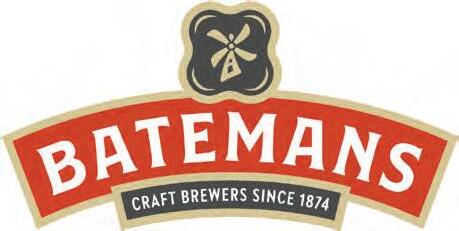
Roger Protz visits Batemans and discovers the resilience needed to survive and prosper for 150 years
To have brewed Good Honest Ales for 150 years would be cause for celebration at any time, but Batemans can raise a collective glass in the knowledge it survived the Covid-19 pandemic and lockdowns, and is brewing full bore again.
Its survival is all the more remarkable when you consider that since 1874, the brewery in Wainfleet, Lincolnshire, has fought through world wars, recessions and a family split that almost killed the company in the 1980s.
Taking a cue from its popular Christmas beer, you could say Batemans is coming up Rosey Nosey (4.7 per cent ABV).
But it’s been a hard few years and MD Stuart Bateman will never forget one critical date.
“On 20 March 2020, I stood on pallets in the brewery yard and told the staff to go home,” he said. “I said only a skeleton staff would keep things going and if any vultures came sniffing around to buy us they would be seen off. If we sink, we all sink together.”
Stuart, who with his sister Jaclyn represents the fourth generation of the family, worked throughout the pandemic and learned to drive a forklift truck. With his finance people, he had to revise the business model drastically.
“We took stock back from customers with credits,” he said. “We had to advise

‘The sails had fallen into disrepair and were removed. The armless windmill became a landmark and went on to become the brewery’s logo’
tenants on how to get grants and we reduced their rents by 90 per cent. As soon as the first window opened, the stock went back into the pubs. We had to renegotiate all supply and free trade agreements and reduce our targets.”
Brewing was reduced to limited amounts of small-pack and take-home. Local people came to the brewery to fill containers while Batemans’ most famous and prize-winning ale, XXXB (4.8 per cent), suffered the indignity of being converted into hand sanitiser.
The brewing team had to repropagate the yeast when it was possible to start brewing in earnest again. The full core range didn’t return until the team was satisfied the yeast was working well and at first just one beer was produced. It was based on XB (3.7 per cent) and was called Revival (4 per cent).
In August 2021, all restrictions were lifted. It was revival time and Stuart and his board introduced a slimmed-down business model. While pub rents were gradually restored, two pubs with low beer sales were sold. The brewery now has 50 pubs in an area that takes in Lincolnshire, Norfolk, Peterborough, Derbyshire, South Yorkshire and Hull.
Stuart and his team cast an eye on all levels of the business and took the difficult decision to close the visitor centre that was once open every day of the week. Today, only pre-booked tours are available and the centre is also used for weddings and parties.
There was an ominous sign when the Virginia creeper that covers the iconic windmill fronting the brewery cracked and died. Five more creepers were hurriedly bought and planted: “We had to convince people the brewery hadn’t died as well!” Stuart said.
Far from it – Batemans has emerged from the crisis in a strong position with all
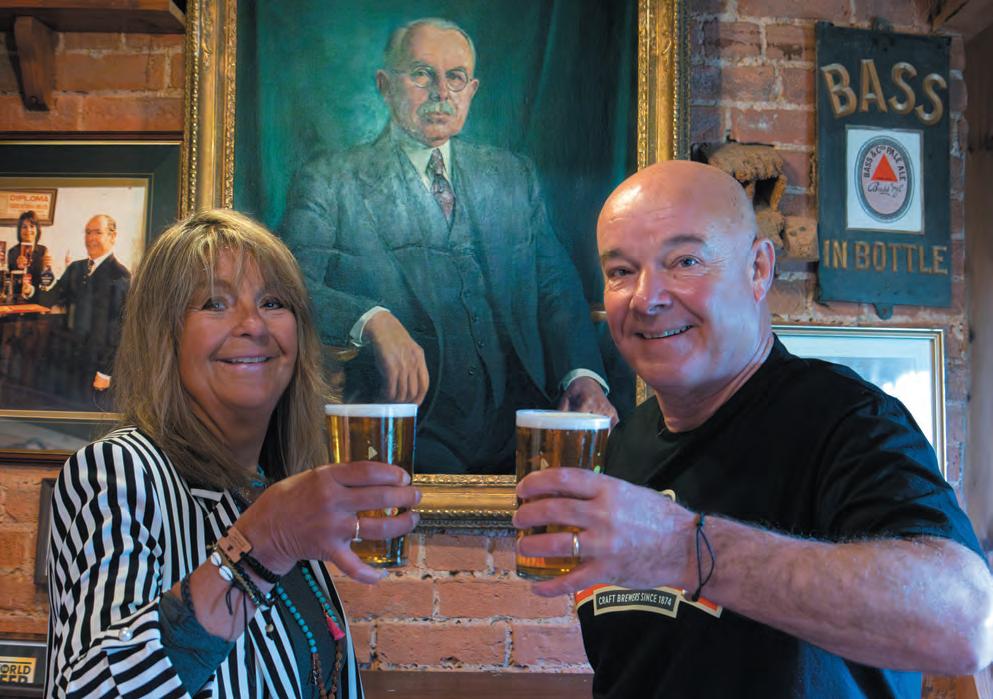
suppliers paid, a new tenancy agreement for its publicans, the sales team back in place and, crucially, beer output in growth.
The 150th anniversary was marked on 23 April – St George’s Day – by a celebratory lunch attended by brewers, suppliers, friends and supporters. The family was able to look back with pride and awe at their survival and success over such a long and turbulent period.
George Bateman was a farmer who turned to brewing with the support of his wife, Susannah. They were sufficiently successful to move to Salem House in Wainfleet: it’s thought Puritans in the area took the name Salem with them when they crossed the Atlantic and settled in Massachusetts. The brewery flourished when George’s son Harry joined and won contracts to supply beer to the armed forces during World War I.
Harry expanded the business by buying pubs, including in Skegness, which was becoming a popular seaside resort. His three children, Helen, George and John, laid the foundation stone in the 1930s at the first holiday camp run by Billy Butlin, and Batemans supplied the camp’s bars with beer.
The brewery survived the recession of the late 1920s and early 30s, and production moved across the road from Salem House to buildings that included
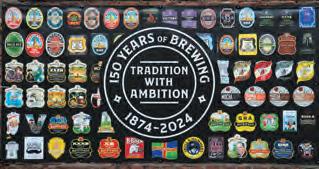
‘The 150th anniversary was marked on 23 April. The family was able to look back with pride and awe at their survival over such a turbulent period’
a windmill that had been used to grind corn for local bakers. The sails of the mill had fallen into disrepair and Harry removed them. As a result, the creepercovered, armless windmill became a landmark in Wainfleet and went on to become the brewery’s logo.
World War II, in common with the Great War, brought some advantages for the brewery. Butlin’s holiday camp in Skegness was requisitioned by the government and became a naval station called HMS Royal Arthur. Batemans continued to supply beer but in greater volumes to notoriously thirsty sailors.
When Harry’s son George joined the business in 1950, it owned 68 outlets and that number grew due to George’s drive. He’d trained as a brewer with Greens of Luton and he radically overhauled production at Wainfleet with more modern equipment. He introduced new beers such as pale ale and bitter as the popularity of dark mild went into decline. Harry had dubbed the brewery’s beers

as Good Honest Ales and George used the slogan on labels and pub signs.
George added a further 29 pubs to the estate, but hard times arrived in the 1970s. A series of mergers created six national breweries which flooded the market with keg beers that were backed by mass advertising. The decline in sales of Batemans beers was so drastic that George was forced to produce his own rudimentary keg, but it failed to meet the pulling power of the national brewers.
“The prospects looked grim,” he recalled, “and then a knight in shining armour rode in. The Campaign for Real Ale began to reawaken people’s enthusiasm for beer with more flavour and character. So, once again, the foaming head on a Batemans ale was in demand.”
The future looked secure. In 1984, Jaclyn (George’s daughter) joined the brewery, closely followed by her brother, Stuart, who had been on a three-year brewing and business course with Mansfield brewery. Light and dark
‘Stuart took the hard decision to cut annual production from 30,000 barrels to 6,000. “If we hadn’t made the move, we wouldn’t be here today”’
milds and XB were joined by the premium XXXB.
And then a body blow struck the company. In 1985, George’s brother and sister, John and Helen, announced they wanted to sell the brewery and retire to homes in the sun. They controlled 60 per cent of the shares and two frantic years followed as George attempted to raise the cash to buy out his relatives.
The tide turned in a dramatic fashion in 1986, when XXXB won the prestigious Champion Beer of Britain award at CAMRA’s Great British Beer Festival. The story of Batemans’ battle for survival became national news and as a result, the Midland Bank agreed to advance the cash to allow George and his family to pay off John and Helen. A special beer,
Victory Ale (6 per cent), was produced to fuel parties at the brewery.
The bank loan of £3.6m had to be paid off. Jackie as marketing director set up a network of wholesalers and export agents to make the beers more widely available domestically and abroad.
A few pubs were sold while Stuart overhauled the free-trade side of the business and took the tough decision to sell it to Carlsberg Tetley. The family was able to repay the life-saving bank loan and Batemans could breathe again and look forward to a prosperous future.
But sadness followed in the wake of the victory. George and his wife Pat both died, in no small measure worn down by the years of struggle.
And then came what Stuart calls “the perfect storm” of Progressive Beer Duty, now called Small Brewers Relief (SBR). This reduced by as much as 50 per cent the amount of excise duty small brewers paid on their products.
While Batemans remained the biggest brewery in the county, it was undercut
‘A range of seasonal beers called the World Hop Tour has been introduced to the line-up. The first, Triple Hop, is brewed with three American varieties, and a beer with New Zealand hops is next’
by 20 or so new small producers taking advantage of SBR. Stuart took the hard decision to cut annual production from 30,000 barrels to 6,000. “If we hadn’t made the move, we wouldn’t be here today,” he said, emphatically. He concentrates on his tied trade while free-trade sales have started again and are now bigger than at the time of the Carlsberg deal.
New beers have been introduced, with Gold (3.9 per cent) rapidly becoming a major seller. XB remains the main brand while XXXB is staging a comeback.
A range of seasonal beers called the World Hop Tour has been introduced to the line-up. The first, Triple Hop (5.3 per cent), is brewed with three American varieties, and a beer with New Zealand hops is next.
A new regular beer was introduced to mark the 150th anniversary. It’s called Five Generations (4.2 per cent) to prove that young members of the family are waiting to take over the business.
Stuart’s son Harri is currently working at Beavertown brewery, but will come home to Wainfleet, while his second son Edward is on a graduate brewing course with JW Lees in Manchester. His daughter Eliza is an expert in new technology and has overhauled the social media and online sales of the business.
Stuart is cautiously optimistic about the future and plans to grow production to 12,000–15,000 barrels a year. There will be new pump clips and labels for the beers with the slogan Tradition with Ambition.
“We may do some keg or keykeg, but they won’t be core,” he stressed. “We’re good at cask – it’s in our DNA.”
Batemans’ revival has been helped in no small measure by having Buster Grant as the new head brewer. Buster had not only won awards for his beers while working in Wales, but was a much-admired former chairman of SIBA, the Society of Independent Brewers, now the Society of Independent Brewers and Associates, the champion of small producers.
He has had a peripatetic life, growing up in both the Scottish Borders and on a farm in Kent. He lived in South Africa before returning home to work as a sound engineer.
He had an early brush with Batemans. He met Jaclyn at the Great British Beer Festival (GBBF) in London in 1992 and asked if he could work at the Batemans bar. She agreed and he enjoyed it so much that he has volunteered to run bars at GBBF ever since.
He now has a passion for beer and completed a one-year master’s degree course at Heriot-Watt University’s department of brewing in Edinburgh. From there he went to work at Brakspear’s in Henley-on-Thames and was there until it closed in 2002 – “a very sad occasion,” he said.
He moved to Wales where he brewed for both Breconshire and Brecon
breweries and twice won the Champion Beer of Wales award. When Brecon merged with the drinks group Cold Black Label in 2018, Buster moved on. He was already heavily involved in SIBA. He was elected to its council in 2008 and became chairman in 2017 and was pitched into a fierce debate over SBR.
He had to attempt to bridge a yawning gap between the brewers, which produced fewer than 5,000 hectolitres a year and received full duty relief and those in the ‘squeezed middle’ that got little or no relief.
“They were unfairly penalised,” he said. “Duty had been increased so much over a 10-year period that we needed to lower all rates.”
He thinks the revisions made by the government in 2023 satisfied most brewers. “People who brew more than 5,000 hectos can now grow and invest in their businesses.
“But growing market share is difficult for independents because
‘Buster had not only won awards for his beers, but was a much-admired former chairman of SIBA’
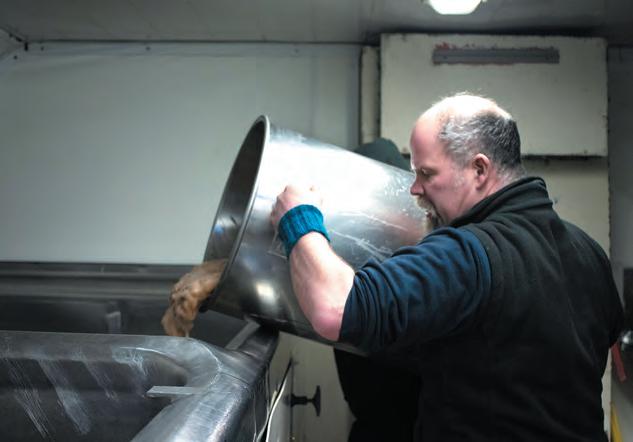

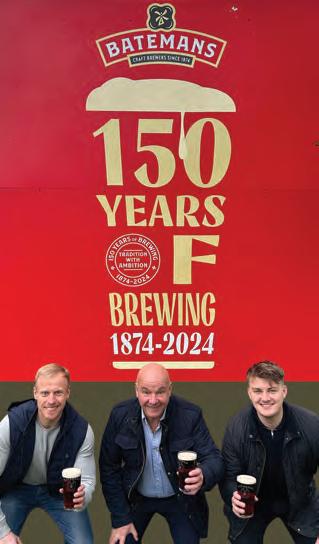
of the power of the global and national brewers. They want to get into craft beer as well as lager and they’re buying successful breweries.”
When the head brewer’s job at Batemans was advertised, he came to Wainfleet with his wife, Jo. He’d already had a glowing report about the brewery from former head brewer Martin Cullimore, who he’d met in Cardiff, and he was impressed by everything he found at Wainfleet.
He joined in 2023 and was immediately involved in Stuart’s revival strategy for the company and the plans for the 150th anniversary.
“I’ve become part of the family,” he said. “People like working here.”
He respects the traditions of Batemans and said he spent his first six months learning and understanding before making any changes.
“The brewing equipment is very good and I’d be shot if I changed XB and XXXB. Mine is a custodian’s job and
“Volumes are not as high as 20 years ago, but quality was not good then. Pubs that serve cask well are doing a good trade”
I need to transfer knowledge to the next generation of Stuart’s children.”
Buster may not change the existing range, but he has been at the sharp end of introducing new beers such as the World Hop Tour and Five Generations, which will become a regular beer.
He says the revival of cask beer will be tough, but he’s optimistic.
“Volumes are not as high as 20 years ago, but quality was not good then. Beer quality is vital. Pubs that serve cask well are doing a good trade. The number of outlets will decline, but those that serve cask in good condition will thrive.”
He describes himself as “an old-school head brewer” and starts work at 6am. The only mishap to date was rising at dawn in October 2023 to find the River Steeping had overflowed and flooded his house. Welcome to Wainfleet!

Roger Protz takes to the trams and explores Belgium’s West Flanders coast
With a hiss of brakes, the sleek two-car tram glides to a halt. People hurry on board, going shopping, to work or – as this is Belgium – heading off to a café for a beer.
The tram ride is smooth, comfortable and surprisingly fast. This is De Kusttram, a tram service that runs the length of the West Flanders coast from the borders with France to the west and the Netherlands in the east.
Along the route of the Belgian Riviera you will take in fine views of beaches and the sea, sand dunes, memorials to kings called Leopold and the occasional Albert, and a series of towns with superb belle époque buildings.
The Kusttram is also the ideal way to enjoy the beery delights of the region, with many excellent bars close to tram stops and a growing number of small breweries producing a range of beers of impressive quality.
I based myself in Ostend, midway along the tramline. It’s far more than a sea port, with popular beaches, a busy fishing and shrimping industry, museums and a 19th-century sailing ship, the Mercator, based in the main harbour. There’s also a host of bars with sufficient beers to satisfy the most passionate connoisseur.
My hotel was proof that Ostend takes beer seriously. It’s called the Botteltje – the Little Bottle – and, to prove the point, a large bottle sign overhangs the street. The hotel rooms cost from €85, which makes
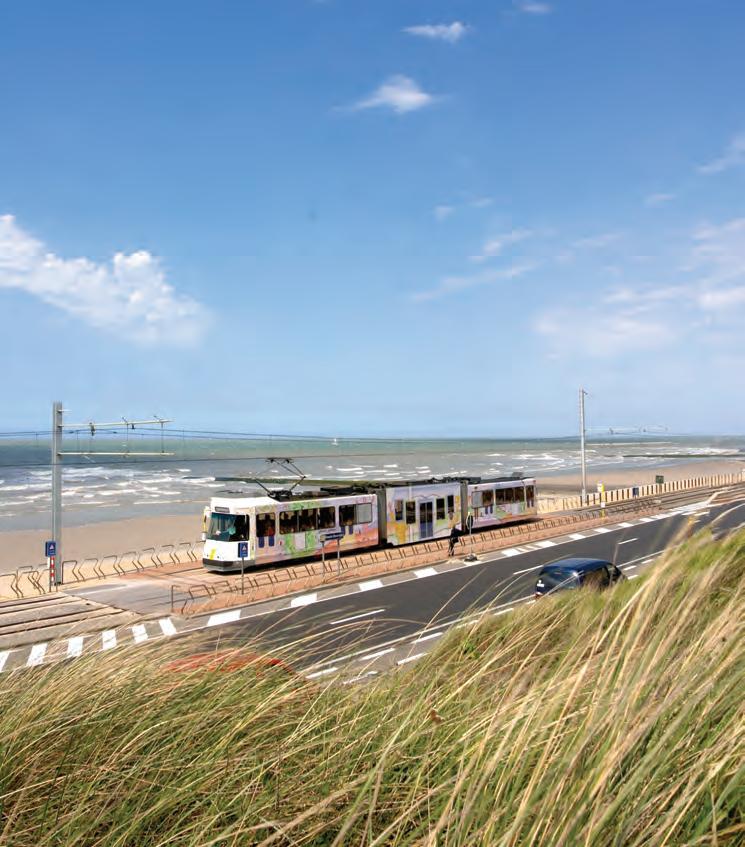
them excellent value. Each room is named after a Belgian brewery; I was in the Rodenbach Room with a large floor-toceiling photo of the giant oak vessels where the beer is aged for a year or more.
The café is spacious, with art nouveau touches. It’s dominated by a large, curved mahogany bar with comfortable booths, beer advertisements decorating the walls and, most importantly, a menu with 300 beers. They include two house beers, Ostensche Strever Blonde (7.7 per cent ABV) and
‘The Trappiste Fondue is prepared with Chimay while the special Brewers Menu offers shrimp and cheese croquettes cooked with Chimay’
Quadrupel (10.5 per cent) from local breweries. They are complemented by such familiar names as Chouffe, Duvel, La Trappe and St Bernardus.
In the restaurant the emphasis is on cooking with beer. The Trappiste Fondue is prepared with Chimay while the special Brewers Menu offers shrimp and cheese croquettes cooked with Chimay, carbonnade flamande with Westmalle Dubbel (7 per cent) and crème brûlée with 8 per cent St Bernardus Prior 8 (Café/Hotel Botteltje, 19 Louisastraat; botteltje.be).
The blonde house beer comes from ‘t Koelschip brewery, a short stroll from the hotel at 101 Van Iseghemlaan. It’s run by Ive Mostrey and his wife, Sandy Major: Sandy is the brewer, Ive front of house. The brewery is tiny and produces
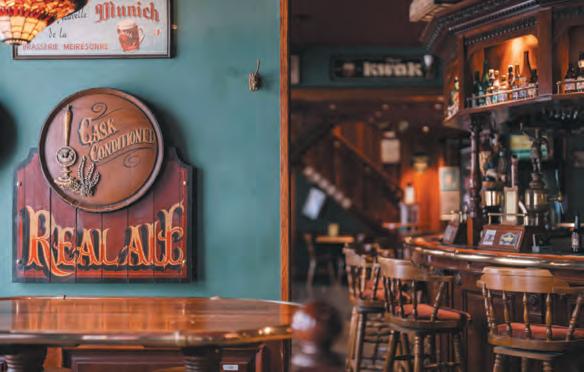

just 500 hectolitres a year. Koelschip (or coolship) is the name given to the open pan used by lambic brewers to allow the wort or malt extract to be attacked by wild yeasts. Ive and Sandy can’t use the term ‘lambic’ as it’s confined to breweries based in and around Brussels, but they produce two beers by spontaneous fermentation, leaving them in open tanks and then ageing them in Geneva (gin) barrels. They are tart with apricot fruit and bittersweet finishes.
The brewing kit was built in China and Sandy uses malts from Simpsons in England and hops from Poperinge. They produce 12 beers for local cafés and restaurants: one beer, Dokter Klaas (8.4 per cent) supports the local music scene and is taken by 25 bands. All the beers are at least three months old and
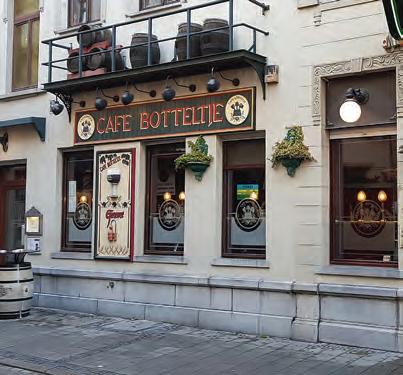

‘Ive and Sandy can’t use the term “lambic” as it’s confined to breweries based in Brussels, but they produce two beers by spontaneous fermentation’
enjoy six weeks cold and warm conditioning. The Christmas beer for 2023 was brewed in August.
There are regular events at the brewery and other small brewers can use their kit. Visitors are welcome but reservations have to be made using the website blondekuif.be. There are tables and seats on the pavement where the beers can be sampled.
This area of Ostend was home to the American entertainer Marvin Gaye in the 1980s. His favourite bar was
Lafayette at 12 Langestraat, which has 60 beers including Alvinne, De Dolle, Dupont and Oud Beersel. Across the road, the Manuscript (23 Langestraat) is popular, as the name suggests, with writers and journalists. It has 70-plus beers with Trappist and gueuze among the number.
A sign above the bar at the Jus de Mer brewery says in English: ‘It’s always beer o’clock’. It’s a promising start to a visit to the brewery in Middelkerke, a few miles south of Ostend. The bar is in the attractive raftered top floor of the building where private parties are held and is open to visitors who must make appointments (142A Westendelaan, Middelkerke; jusdemer.be).
The brewery opened in 2017 and the founders, Bart Mortier, Alexander
Verlinde and Stijn Roels, have restored beer making to the site of the Lion D’Or brewery that was ransacked for its copper vessels by the invading Germans in World War I. At the time, French was the dominant language and the French connection has been maintained by calling the old Golden Lion brewery Jus de Mer – Sea Juice.
The brewing kit has a mash tun, mash filter and boiling copper. Malt and a small amount of corn are balanced by Belgian Fuggles and Saaz hops from Poperinge. The local water is hard: “It feeds the yeast,” Stijn says.
The two regular beers are Blond (7.2 per cent) and Dubbel 8 (8.8 per cent). Around 1,200 hectolitres are produced a year and 80 per cent is sold along the Belgian coast. Blond is hoppy and aromatic, with orange fruit on the nose. It has a fruity palate with herbal hops and a long, bittersweet finish with continuing fruit notes.
Dubbel is brewed with five malts, including Pale, Caramel, Chocolate and Munich. It’s deep bronze in colour with a herbal and spicy aroma balanced by rich malt, chocolate notes and spicy hops on the palate and a big bittersweet finish.
Recommended bars in Middelkerke: Iceberg (132 Zeedijk) sits on the seafront near the casino and has 80, mainly regional, beers. Venus (86 Zeedijk), on the seafront close to the Casino and Greefplein tram stops, has some 120 beers.
I had a memorable eating and drinking experience at Heerlijk on the border between Middelkerke and Ostend and close to Ostend-Bruges Airport. Heerlijk means delicious and the charming owners, Vicky and Kevin Vandromme, are not exaggerating the appeal of their ‘beer restaurant’. They opened in 2017 after going on specialist courses to learn about beer. As a result, they have a range of more than 200, including every Trappist beer.
They have a tasting menu with recommended beers for each course.
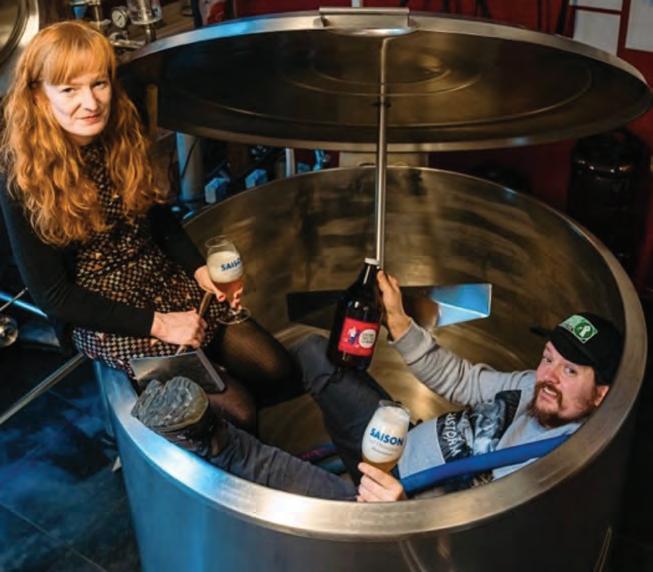

‘They have a tasting menu with recommended beers for each course. The menu changes monthly and uses seasonal food as well as local fish; vegetarians are not ignored’
The menu changes monthly and uses seasonal food as well as local fish and seafood; vegetarians are not ignored. My visit coincided with the asparagus season and my starter was the beautifully prepared vegetable in a delicious sauce, with a glass of Zeevonk (7.2 per cent) from a brewery of that name in Koksijde. Zeevonk is a form of plankton and a touch of it in this blonde beer gives a spicy aroma and palate balancing honeyed malt and green apple fruit.
My main course was a veggie burger with mushroom sauce accompanied by King Mule IPA (5.7 per cent) from the Cornelissen brewery in Opitter, a family brewery dating from the 1880s. It’s hoppy and fruity with tangerine on the nose and a bitter and fruity palate and finish.
I usually don’t bother with dessert, but that would have been a major mistake as it came with one of the most remarkable beers I have tasted for some time. The
dessert was fresh strawberries with celery, an unusual but tasty mix. The beer was Lambic & Stout (6 per cent), a blend of Timmermans Lambic from Itterbeek with Guinness. Before you rush, this is an annual brew and is not always available. It has a big nose of roasted grain, light hops and lactic sourness. The lactic notes grow on the palate with a firm balance of roasted grain, oak and chocolate. The long finish is immensely complex with sour fruit, roasted grain, chocolate and oak. The restaurant is spacious and comfortable with a garden terrace and a separate tasting room. Heerlijk (893 Nieuwpoortsesteenweg; bierrestaurantheerlijk.be) is closed Mondays and Tuesdays.
Back on the tram, I head north to Blankenberge, a major seaside resort with a casino, marina, an annual carnival and plenty of bars to cope with the crowds. I begin my visit with a brewery launched part-time in 2016 and fully operational since 2019. Brouwerij B (1 Gildestraat; brouwerijb.com) is run by two brothers, hence the B in the name, Jan and Pieter De Soete. It also stands for Blankenberge and Beer. Jan and Pieter were keen home


brewers and started to brew commercially part-time until demand for their beers increased the output. They still have full-time jobs and only Pieter was on hand when I called.
They brew 250–500 litres a week with kit made in Hungary and Slovenia. The first beer was Real Love (7.5 per cent), brewed to celebrate Pieter’s marriage. It’s the best-selling beer available along the coast and into the Netherlands, and has orange fruit on the aroma and palate, and a floral note from German hops. Continuing the theme, Dark Love (8.5 per cent) is a malt-led beer with


‘I usually don’t bother with dessert, but that would have been a major mistake as it came with one of the most remarkable beers I have tasted for some time’
chocolate and coffee notes and a herbal hop presence.
A beer called B15 (7 per cent) is fermented with champagne yeast and celebrates the bravery of the brothers’ grandfather – still alive at 95 – who escaped to England from Dunkirk on a ship called B15 during World War II. A stout is also 7 per cent and is called Roesschaart, meaning sea devil. It has an addition of red fruit and is bittersweet with a big chocolate hit and additions of roasted grain, herbal hops and tart fruit.
All the beers are bottle-conditioned and the brothers plan a spontaneously
The coastal tram system dates from 1885 and was built when the young Belgian nation had train fever, building lines throughout the country at breakneck speed. The Kusttram is the last-remaining major tram line and runs for 42 miles along the coast from Knokke-Heist to De Panne, linking the Netherlands and France. There are trams every 10 to 15 minutes at peak times, fewer in the evening. Travelling the entire line takes 150 minutes, with some 67 stops. A day ticket costs €7.50.
fermented beer dubbed, tongue-in-cheek, Blambic (7 per cent). The brewery has a bar and taproom and serves two Saturdays a month; check its website for dates.
In Blankenberge, the Terminus bar at 1 Leopold III Plein is close to the tram terminal in the town centre and has 90 beers, drawn mainly from West Flanders. Herman (102 Kerkstraat) is also handy for the terminal and has 100 beers, while Luxembourg (75 Zeedijk), close to the Markt tram stop, offers 80.
On the tram towards Ostend, a stop at De Haan is obligatory. It was once a fishing town, but in the 19th century it was transformed into a place of belle époque splendour that even includes the main tram stop, De Haan Aan Zee.
Close to the stop, De Torre (the Tower; 2 Hans Memlinglaan) can’t be missed with its four storeys and imposing tower. It has one of the best beer lists in the region that includes gueuze, Wallonian saison, wheat and old browns. It is closed Mondays and Tuesdays.
I had time on my last day for a fine lunch at Grand Café du Bassin (1 Visserskaai), conveniently sited close to Ostend station. I enjoyed cheese croquettes and a glass or two of spicy Petrus Blond (6.5 per cent) from the family-owned De Brabandere brewery near Kortrijk. It kept me content on the journey back to Brussels and London.
Getting there: Eurostar from London St Pancras International to Brussels Midi (two hours), then Brussels to Ostend (one hour). There are no longer ferries or hovercraft from Dover and Folkestone to Ostend, but if you’re based in the north there is the option of taking one of the ferries from Hull to Zeebrugge. ● The writer acknowledges the support of Visit Flanders UK and Frank Vansteeland of Westtoer, the West Flanders tourist board: westtoer.be

You may not be familiar with the name Georgina ‘George’ Young, but you will know the beers of which she has been, or is currently, the guardian. The list reads like tracks on a greatest hits album – London Pride, ESB, Hophead, HSB, Tribute, Proper Job – and that’s just side one! George is currently the brewing director at St Austell, which also owns Bath Ales, and before that she had the same role at Fuller, Smith & Turner, so real ale is central in her working life.
What makes a real ale hero? If it is awards, recognition, longevity, dedication and advocacy, then George can claim all of those. Last year was a notable one for awards and recognition, because not only was she honoured with a Lifetime Achievement Award from the Brewers’ Congress, but she also received the British Guild of Beer Writers’ Brewer of the Year accolade.
For beer enthusiasts, that first taste of real ale stays in the memory, and with George it was a sip of her Dad’s Courage Directors (4.8 per cent ABV) in Bristol where she grew up. However, there was one drinking experience that would prove to be prescient. “My boyfriend took me to the Dove (a Fuller’s pub) and I drank a pint of London Pride [4.1 per cent] as that was what he ordered for himself. I really

enjoyed the sweetness and complex flavour and the fact that it wasn’t really gassy like the lagers which I normally drank.”
It was during her undergraduate studies in biotechnology at King’s College in London that brewing became a passion and it inspired her to take a master’s degree in brewing and distilling at Edinburgh’s Heriot-Watt University
“I drank a pint of London Pride. I really enjoyed the sweetness and complex flavour and the fact that it wasn’t gassy like the lagers which I normally drank”
where classmates included John Keeling and Roger Ryman, both of whom she would work with later in her career at Fuller’s and St Austell respectively.
Learning on the job is the most effective way of absorbing the fundamentals, so George’s time working in the laboratory at Bristol’s Smiles brewery, then progressing to shift brewing was the experience she needed to later run the pilot brew facilities at Brewing Research International (now Campden BRI). The work involved assessing raw materials and their performance, recreating beers, flavour profiling and making sensory assessments. The latter
three skills were priceless when George became a production brewer at Fuller’s and the company took over George Gale & Co of Horndean and transferred brewing operations to its Griffin brewery in Chiswick, West London. This meant George had to analyse every aspect of the beers, understand how they performed with the foibles of a different brewery, know what to tweak – whether that was the grist, temperature or the fermentation – all with the aim of replicating Gale’s tasting profile.
Real ale is not just water, malt, hops and yeast, it is a living being for which its fans have an emotional attachment. Reconstructing beloved brands such as Gale’s HSB (4.8 per cent) and Seafarers (3.6 per cent) is a pressure-inducing activity, because even though a beer may be owned by a company, its spirit is the property of the customers; and when a brand has a regional heartland, then provenance is a major factor. Independent taste panels agreed that George’s flavour matches were accurate and Gale’s devotees continued happily drinking their favourite beers.
Right: George Young – education is key to cask beer’s future
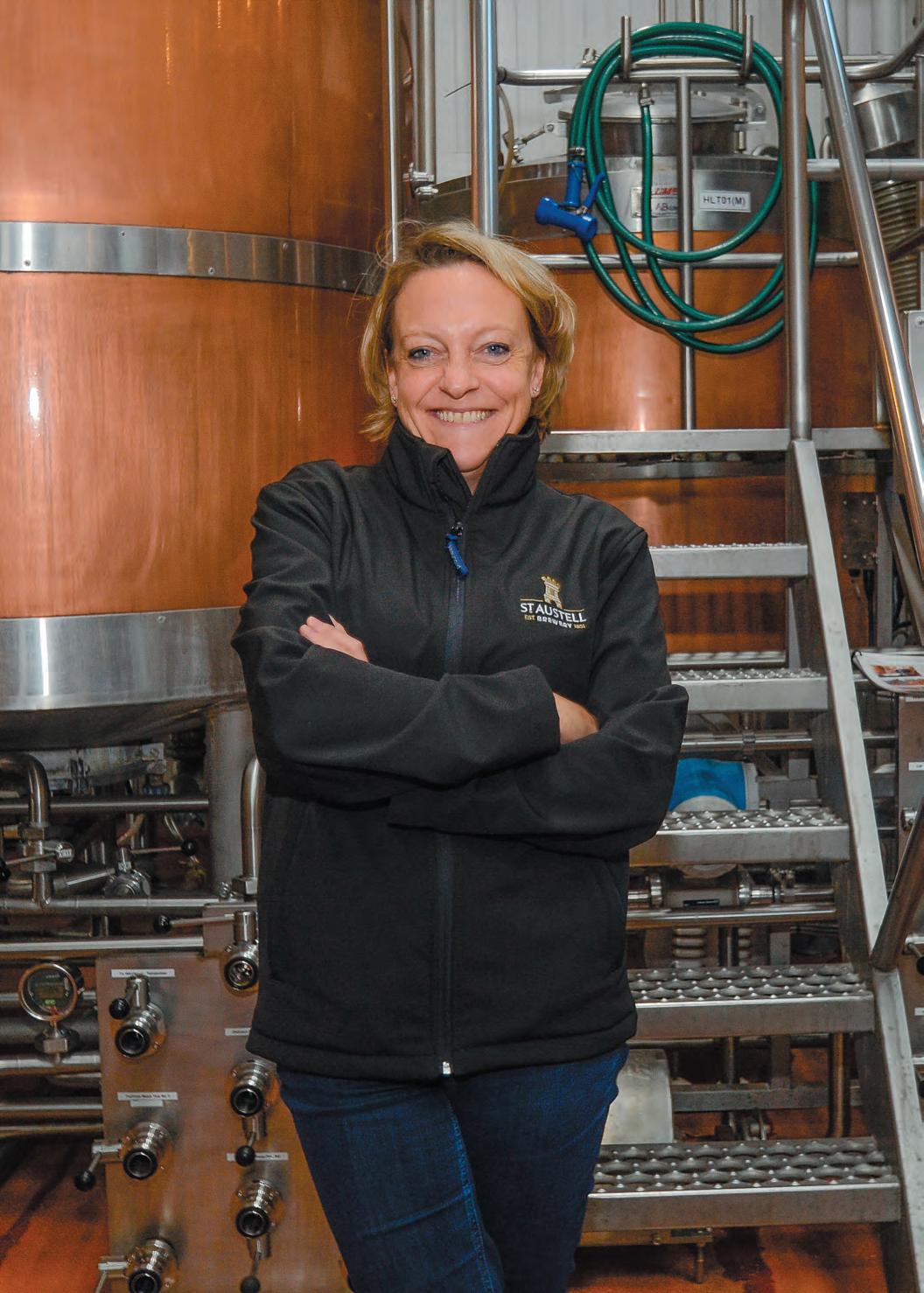

George had another challenge with Gale’s Prize Old Ale (9 per cent). It is one thing to recreate beers from scratch, but to relocate a brew from Horndean, where it was ageing in a wooden vat, into a stainless-steel tank at the Griffin brewery and care for it for the remainder of its maturation is another, but that is what happened with the celebrated bottle-conditioned old ale. The acclaim it received on release is testament to George’s skills. It happened again when Fuller’s purchased Dark Star and the production of its flagship beer, Hophead (3.8 per cent), was transferred to Chiswick.
George is not only adept at recreating ales, she is also skilful at creating new ones, like Fuller’s seasonal Red Fox (4.3 per cent) and Jack Frost (4.5 per cent), and the permanent Oliver’s Island (3.8 per cent), and now at St Austell, Anthem a 3.8 per cent ABV golden ale.
“I have huge love for British barley and I’m passionate about English hops. They are subtle, reserved and refined, and they do not mask the contributions from the malt – the biscuits and toffee notes that you want coming through from a great British ale. We don’t talk enough about malting barley, but it’s definitely the soul of the beer,” she said. Anyone who has sipped a beer developed by George will agree that malt always has a starring role in her well-balanced brews.

George is significant in cask ale brewing now and plays a role in its future with her enduring support of the next generation. Several of the junior staff she mentored have moved on to senior positions – Fergus Fitzgerald at Adnams, Rob Topham at Buxton, Henry Kirk at Sunken Knave and Hayley Pearce at Siren Craft Brew. She considers education to be vital and encourages her staff to study for their brewing diplomas. When asked what her brewing legacy would be, the answers were about quality and efficiency – typical of an unshowy person who values working in the background for the good of the company over individual public recognition.
How frustrating it must be for a brewer to create a perfect beer, then be powerless once it has left the brewery because they are reliant on pub staff to understand cask ale. For brewers working in a pub-owning company there is more control over the beer’s fate and this is where education is vital. George’s senior roles at Fuller’s and St Austell, with more than 580 pubs between them, means she has been able to implement training and advocacy in both companies. At Fuller’s she introduced
“[Cask is] pure, fresh and has a wonderful range of flavours that are enticing and don’t need to be masked with powerful hops and lots of fizz”
the beer champions role in the pubs and encouraged staff to complete the Cicerone Certified Beer Server programme. For several years at Fuller’s, George ran the Trade Quality Team, and now at St Austell she ensures managed pubs focus on quality because “along with the kitchen, the cellar is the engine room of the pub”.
Beer sommelier Annabel Smith is a leading cask ale trainer and vouched for George’s focus on excellence. “George was working at Fuller’s and there was a segment in a video produced by the Beautiful Beer campaign with her talking about how special cask beer was, and how it needed to be nurtured and cared for. The way she put her message across massively inspired me, so for the next few years at the start of every training course I ran, I played that segment.”
How would George describe cask ale to a person with no experience of it?
George replied: “Malt, hops and yeast unite to give amazing combinations and styles. Nothing is filtered out, so the yeast gives it natural carbonation and the unique flavours are still there after the conditioning process. It’s pure, fresh and has a wonderful range of flavours that are enticing and moreish and don’t need to be masked with powerful hops and lots of fizz.”
Brewers are in a priceless category of people whose work brings joy to others. This was particularly apparent when I attended St Austell’s legendary Celtic Beer Festival where 2,000 beer lovers had 116 beers to choose from. George was busy behind the bar pulling perfect pints, but it is unlikely many people there knew she was the leader of the team responsible for most of what they were drinking.
The atmosphere was buzzing and the range of beers was heaven. “That’s the whole thing about being a brewer, the sense of making something that brings people so much enjoyment when they go down the pub or get together to have a bit of a community spirit. That’s where you get the biggest kicks as a brewer.”
Write to BEER, CAMRA 230 Hatfield Road, St Albans, Herts AL1 4LW or email editor@camra.org.uk
As a life member of CAMRA and a keen follower of CAMRA’s Britain’s Best Real Heritage Pubs by the late lamented Geoff Brandwood, I have always enjoyed visiting the remaining 14 tiled bar counter fronts in the UK.
One of the best manufacturers was Craven Dunnill of Jackfield, Shropshire. This firm is very much still in business, and I was recently taken aback to find a brand new bar front just installed in the refurbished Fanny Talbot in Barmouth, Gwynedd.
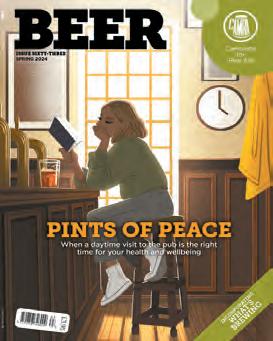
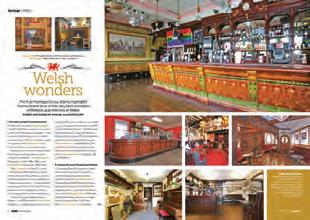

It is identical in design to those in the Mountain Daisy, Millfield, Sunderland, (pub 159 in Geoff’s book) and the Golden Cross, 1903 (pub 210).
The installation means the UK total has now increased from 14 to 15. In those two pubs the colour of the ceramics are two tone, but the new one in Barmouth is a handsome deep blue.
Barmouth is very fortunate in having a very enterprising developer, Jamie Brooks, and this chap certainly knows how to restore an old building and he has brought several other premises back from the dead.
I would strongly recommend the consideration of this pub (formerly known as the Lion) for a CAMRA award. Incidentally, Fanny Talbot gave several acres of land overlooking Barmouth to the National Trust, the first such gift.
David Bath, Wells, Somerset
David Jesudason’s enthusiasm for using pubs at quieter times (BEER, spring) reminded me that one doesn’t have to be antisocial to be more interesting in opening times than closing times.
Paul Mudge, Stafford
The spring issue of BEERmagazine was the last to feature the quiz, so here are the final answers and winners:
Spring answers: 1 Andy Cole 2 Fear of chickens 3 Moorhouse’s Black Cat 4 Francis Bacon, in 1597 5 They played (not all together) in The Yardbirds 6 Flaubert 7 A car 8 Rock the Boat brewery, Liverpool 9 Kittiwake 10 Australia 11 An instrument for measuring the diameters of small fibres 12 John Thaw 13 Shangri-La 14 Charnwood brewery, Leicestershire 15 Foxglove 16 Probability 17 ‘Blank Space’ – Taylor Swift 18 10 19 Mrs Malaprop 20 John Wycliffe Spring winners: Muriel Edwin, Wooler; John Etheridge, Lincoln; Richard Hopkinson, Banbury; Ivor Richards, St Albans; Phil Sokell, Barnsley
The prize can only be awarded to entrants on the UK mainland. Readers can only win a month’s membership to Beer52.com once. Repeat winners will be offered a £10 voucher for Beer52’s online shop (the minimum spend of £30 applies). Compiled by James Daly. The quizmaster’s decision on correct answers is final when choosing the prize winners.
CAMRA’s Pub and Club Campaigns Committee is looking for a new member to lead on industry liaison. This would be a cross-cutting campaigning role, reporting to the Pub and Club Campaigns Committee. If you are interested in this volunteering opportunity, please provide a summary of your relevant background and experience to campaigns@camra. org.uk
“Build it back wonky!” pleads a placard at the turn for the Crooked House in Himley, the Black Country pub which hit headlines worldwide last summer. After being sold by Marston’s, then suffering fire damage, the pub, with its famously askew dimensions, was hastily demolished.
A passionate public outcry followed, for the Black Country is a region whose post-industrial identity is bound tightly to its historic pubs and traditional beer styles. The very wonkiness of the Crooked House was due to subsidence caused by the coal mining and associated industry dating back to the 18th century, which gives the Black Country its name.
But where exactly is the Black Country? Anyone rash enough to suggest it’s a distant suburb of Birmingham would surely get barred from a Black Country hostelry. On the western
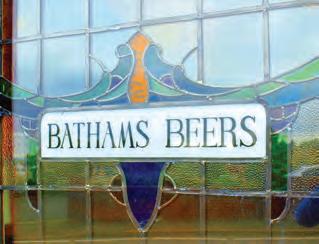
Clockwise from above: Historic Vine features impressive stained-glass windows; conversation starter; Vine has outlasted the nearby Round Oak steelworks, which closed in the 1980s
fringes of the West Midlands conurbation, it’s more a patchwork of interconnected towns and villages with a shared early industrial legacy and a strong, sometimes semi-rural, sense of community and character.
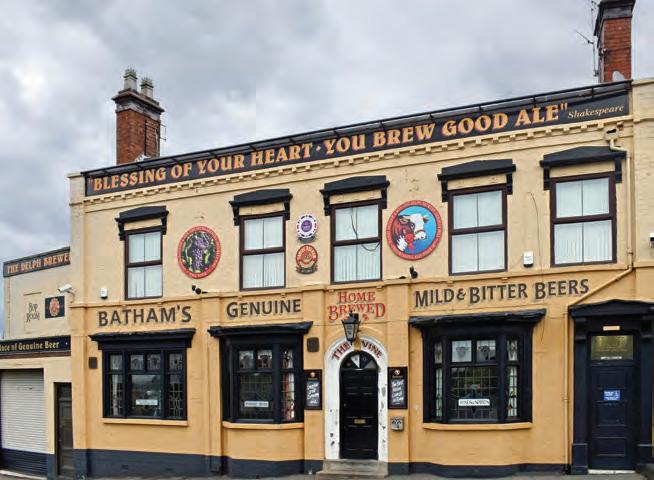

Armed with a day bus pass, I set off to enjoy four pubs within a few miles of Dudley, the Black Country’s unofficial capital, which are all fortunately still intact. All are on CAMRA’s Inventory of Historic Pub Interiors.
The Vine in Brierley Hill stands close to the site of the historic Round Oak steelworks, which closed in the 1980s. Nowadays, it’s surrounded by post-war housing estates with the vast Merry Hill shopping centre nearby. Locally known as the Bull and Bladder, it’s painted a striking two-tone mustard colour with lettering proclaiming the Batham’s brewery tap as the “birthplace of genuine beer”. Shakespeare is proudly emblazoned under the eaves: “Blessing of your heart, you brew good ale.” The Bathams must then be truly blessed as the brewery is now in its sixth generation of family ownership, being currently run by two Batham sisters. Alice recently succeeded her father as head brewer.
‘The Bathams must be truly blessed as the brewery is now in its sixth generation of family ownership, being currently run by two Batham sisters’
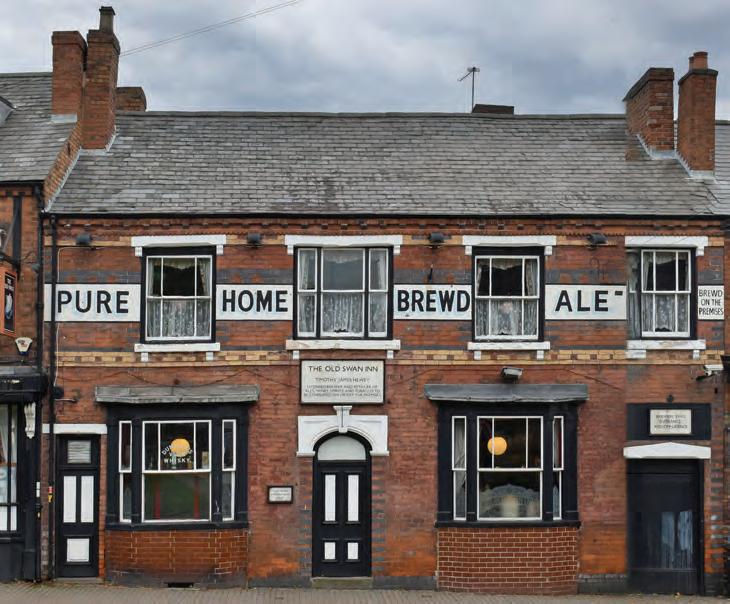

Clockwise from above: Spectacular and eccentric Old Swan Inn is also home to a brewery; Old Swan public bar; rare enamel panels; half piano was the victim of a wayward BMW
Mild is a style particularly associated with the Black Country, one of the few regions where it can be reliably found on tap. Bathams is a fine example: at 3.5 per cent ABV, it’s a true ‘sessionable’ beer, light brown in colour and characterised
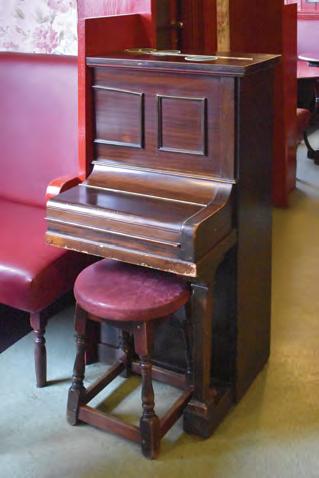
by a smooth malt sweetness. On a busy Saturday lunchtime in the public bar, with pints flowing continuously from the handpumps, it’s easy to imagine how the multi-roomed pub once slaked the thirsts of legions of workers when clocking off shifts at now-disappeared factories.
The lounge bar to the left, lit by the brewery’s stained-glass windows, is a great place to sample the pub’s hearty selection of pork pies and ‘cobs’ –sandwiches the size of small loaves – on a menu that’s probably little changed since the pub was rebuilt in 1912.
A network of 18th-century canals provides a peaceful green thread right through the area. Walking off my pub lunch, I spot a heron fishing in the Delph Locks, a spectacular flight of locks which raise canal barges 85 feet up along the Dudley Canal.
On the bus approaching my next pub, the Old Swan in Netherton, a local Black Countryman points out the site of Hingley’s metalworks, a huge employer for more than a century, even manufacturing the massive anchor for the Titanic. Like other Black Country metal-working firms, Hingley’s also specialised in chain-making, which
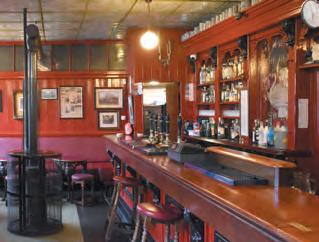

‘The pub, also known as Ma Pardoe’s after the licensee who ran it until 1984, is a labyrinth of nooks, crannies, snugs and back rooms’
explains why the Black Country’s own distinctive flag features a set of links.
The atmospheric, red-themed front bar of the Old Swan is both spectacular and eccentric, well-deserving of its CAMRA three-star historic inventory status. The ceiling is decorated with extremely rare enamel panels, apparently unique in a British pub, centred on a majestic swan. A metal stove squats in the middle of the public drinking area, while in the corner of the bar is a vintage weighing machine.
A sawn-in-half piano abuts the front door – the missing part was sacrificed to refurbishments after a rogue BMW crashed into the bar in 2018.
The pub, also known as Ma Pardoe’s after the licensee who ran it until 1984, is a labyrinth of nooks, crannies, snugs and back rooms. The more modern extensions were constructed around the original layout to preserve the core of the historic Victorian building.
Landlord Tim Newey, who started work at the pub as a teenager, has a reputation
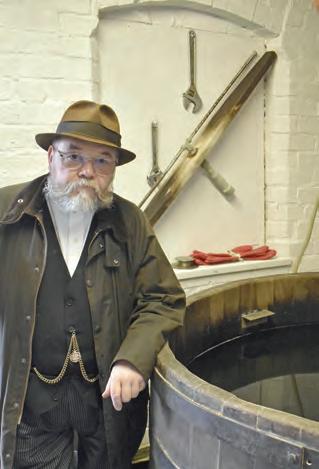
for being turned out equally as smartly as his pub, always wearing a waistcoat with a fob watch on a chain. He takes me on a tour of the Olde Swan brewery (note the additional “e”), which stands in the yard behind the pub. It was one of only four brewpubs in the country when CAMRA was formed in 1971.
The brewery is as steeped in history as the pub. A vintage wooden mash tun on the top floor is still used for brewing its range of beers. My favourite is the curiously named Bumble Hole at 5.2 per cent (it’s a local nature reserve), a golden-coloured strong bitter with a balance of sweetness and hop astringency.
Changes are afoot in 2024 as Tim tells me he will be retiring. Surprisingly, for such an individualistic pub, it’s actually owned by Heineken. It’s believed that it intends brewing to continue under a new tenant. Let’s hope the pub’s other idiosyncrasies long continue.
I take the bus northwards via Dudley to Upper Gornal and the Britannia (also known as Sally’s – yet another alternative
‘The unusual central servery has glass screens facing into the corridor, snug and smoke room that obscure the faces of the customers from bar staff’
pub name!), a Batham’s house and a splendidly preserved example of an urban Victorian pub. There, I sample a pint of Batham’s Best Bitter (4.3 per cent). It’s its biggest seller and another classic: superbly refreshing, initially slightly sweet but with a complex hop bitterness provided by English Fuggles and Goldings hops.
The Britannia’s nostalgically furnished back room is particularly notable due to its working set of four handpumps with a pewter tray installed directly against a wall, with no accompanying bar counter. Once quite widespread, these are now extremely rare. The corridors have splendid examples of Bathams tiling –featuring the company’s trademark ring-nosed bull.
I travel further north to nearby Sedgley. The Beacon Hotel also has a three-star rating for its mostly 1920s interior and incorporates a traditional tower brewery at the rear. The unusual central servery has glass screens facing into the corridor, snug and smoke room that obscure the faces of the customers from the bar staff when ordering.
The dark wood-panelled smoke room with cast-iron fireplaces is packed with beer drinkers. It’s where I encounter Dave Roe. He’s organised annual coach trips to the Black Country for his Buckinghamshire CAMRA

branch for more than 30 years – an option that allows more pub visits than my own wrestling with the region’s bus timetables.
“Best day of the year, without question,” Dave declared. It’s the eighth pub stop of the 2023 trip and he contemplates his pint of Sedgley Surprise (5 per cent) with due reverence.
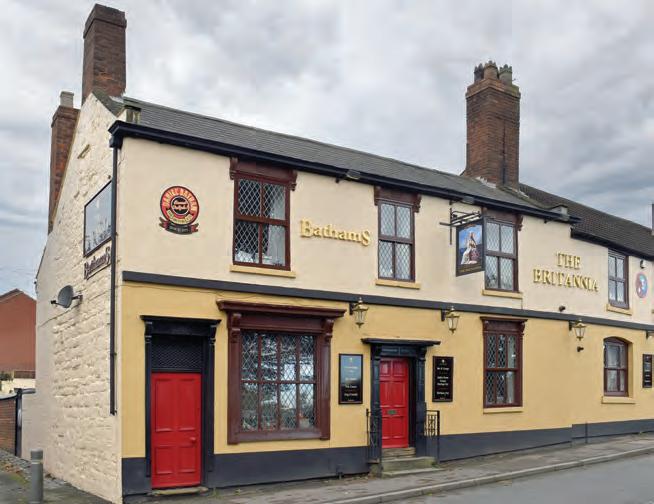

Mark Nicklin of the Sarah Hughes brewery takes me on a tour. It remains much as I imagine it would have been when the woman herself stopped brewing here in the 1950s. An impressive 1930s copper is recessed into the brewery’s second floor. Unusually, it’s heated by direct gas fire, which is believed to lend the beers their distinctively complex malt character.
Sedgley Surprise, a pale, strong bitter, is the brewery’s biggest seller, but it’s most renowned for its Sarah Hughes’ Dark Ruby Mild. At 6 per cent, it’s nearly

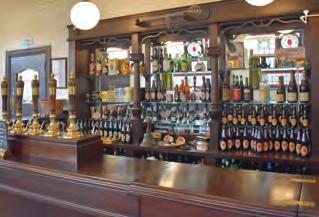
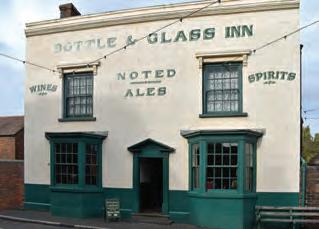
‘Unusually, it’s heated by direct gas fire, which is believed to lend the beers their distinctively complex malt character’
brick by brick, at Dudley’s fascinating Black Country Living Museum, the interior meticulously restored to its 1960s appearance.
The Bottle & Glass was relocated from near the Vine in Brierley Hill. It’s been atmospherically rebuilt as it would have been in the 1900s. The pubs even serve real ale, from local breweries such as Black Country Ales and Banks’s, although only to paying museum visitors.
Perhaps one day the Crooked House will be resurrected here as a museum piece? Meanwhile, we should be grateful that we can raise a classic pint of mild to toast the Black Country pubs that still survive as living, breathing, vital gems within their communities.
twice as strong as most Black Country milds and much darker. It unfolds on the palate with a complex array of rich fruit flavours and a malt roastiness that’s complemented by a hoppy finish.
Like all the beers I sample, Dark Ruby Mild is sought after by beer festivals and free-trade outlets all over the country, but little escapes consumption by local drinkers. It’s no surprise that a visit to the Beacon Hotel is a highlight of many CAMRA members’ years.
The vibrancy of these community pubs contrasts with two pubs I take time out to visit in Dudley itself: the Bottle & Glass and the Elephant and Castle. They’re excellently preserved pubs of the 19th and early 20th centuries, respectively.
The splendidly green-tiled Elephant and Castle stood in Wolverhampton city centre for a century until March 2001. It’s a salutary reminder of how valued pubs can be failed by the planning system. Echoing the fate of the Crooked House, the pub was demolished without warning, also while being considered for listed status. In 2022, it was re-erected,
l There’s an excellent edition of CAMRA’s Pubs. Pints. People. podcast released in December last year, which travelled to the Black Country to investigate mild. It has an interview with the two sisters who now run Bathams brewery, plus an in-depth tasting of its Bitter and Mild. It also takes in the Beacon Hotel and talks to brewer Ricky Follos.


Mike Clarke’s writing has appeared in Pellicle, Good Beer Hunting and other publications. A veteran CAMRA member, he started his beer-drinking career while at university in the West Midlands
Some beers are born great and some of these, it seems, become even better over time. A few tweaks to the recipe, subtle changes to the production process, input from a new brewer – these are all factors that can, incrementally, improve what is already a fine creation. Such is the story of Marble’s Earl Grey IPA (6.8 per cent ABV).
I began researching this beer in 2014 when I spoke to Matt Howgate, Marble’s head brewer at the time. He told me how the beer came to life.
“The idea was born in 2012 after a visit to Belgium and a chat with Brouwerij Emelisse head brewer Kees Bubberman in the crucible of all good discussion – the beer festival,” he said. “The similarities between Earl Grey tea and citrus-fruit hops were floated and the inspiration for a great collaboration beer was born.”
Coming up with the concept of producing a big IPA packed with fresh, fruity hops and enhanced by the addition of Earl Grey tea leaves was the easy part. Putting it into practice was more difficult and sourcing the tea was an immediate challenge.
“After dismissing the idea of buying several thousand individual teabags, we discovered our supplier, Powells, based in Manchester,” revealed Matt. “Just as with our hops or malt, we didn’t want to skimp on tea quality. Powells’ product is top drawer and gives some brilliant notes of bergamot and citrus.”
The next question concerned how best to integrate the tea with the malt and hops. “Our aim was to create a beer that would perfectly complement the
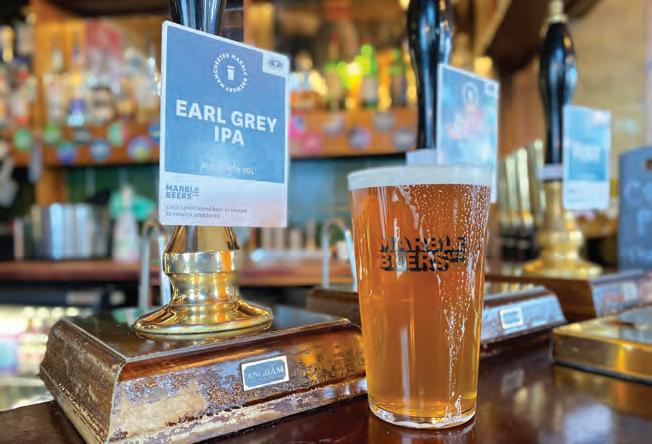
“Just as with our hops or malt, we didn’t want to skimp on tea quality. Powells’ product is top drawer and gives some brilliant notes of bergamot and citrus”
flavours and aromas we’d be getting out of the tea leaves,” Matt explained. “We knew we needed enough sweetness to offset the tannin character of the tea, so we used both Crystal and Caramalt to give a well-rounded malt base and a deep golden colour. For hops, to run alongside the citrus fruit from the tea and to give that punch that we want from IPAs, we went with the definitive US citrus hop, Citra, while a smaller addition of Goldings provided a little traditional character and kept things decidedly English. We then dry hopped our beer in the fermenter with more Citra. This was also when we added the
crucial ingredient – our tea – using the only way we Northerners know how: a giant teabag.
“Originally, the tea – 5kg of it –was left to steep in the beer. No heat was applied, so all the delicate aromas were preserved through to the final product. The beer and the tea were then transferred to a tank for cold conditioning at around 0°C to let the beer mature and the flavours develop. In total, the tea infused for about 10 days.”
Matt has since left Marble and is director of brewing at Vocation brewery in Hebden Bridge. Filling his shoes today is Joe Ince, who updates me on how the beer is now produced.
“The beer still holds a brilliant well-rounded malt and deep golden malt base. However, it’s been tweaked to represent a modern English IPA,” Joe

says. The hops have changed and, so that they don’t overpower the tea, they are now only used in the whirlpool after the copper boil and there is no longer any dry hopping. “The hops have been through several iterations but, for the moment, we are very happy with a whirlpool addition of Sorachi Ace, finding it really enhances and complements the incredible notes of the tea,” he explains.
“The tea we use is still excellent and sourced from Powells,” adds Joe. “However, now it is split down into two or three teabags. This gives it a much bigger surface area and helps us get out as much of the tea and bergamot flavours as we want, without drawing off too much tannin.” To infuse the tea, wort is now drawn from the boil for the leaves to steep in. The tea and leaves are then added into the beer at the same
time as the yeast. “We find this gives a great depth of flavour,” Joe says.
Initially, Marble produced Earl Grey a couple of times a year and it flew out of the brewery. It was not uncommon for casks to run out in a single night. A keg variant was also added, which, according to Matt, offered a subtly different aroma and really brought forward to the taste of bergamot from the tea.
With the opening of Marble’s new brewery in Salford in 2019, Earl Grey was one of the first beers into production. The new facility gave the brewers greater scientific control over the product, and its canning line offered
“Every time someone first tastes the beer, they are blown away by it. The tea adds something familiar and yet a little bit out of the box”
yet another packaging option. Filled with perfumed spice, bergamot orange and leafy tea notes, the beer is now in cask, keg and can, both domestically and internationally.
As Matt told me 10 years ago: “Every time someone first tastes the beer, they are blown away by it. The tea adds something familiar and yet a little bit out of the box, which, combined with a solid, drinkable IPA behind, makes it a real winner.” And Joe confirms that the beer remains “super popular” and is always in stock. But you don’t have to take their word for it. Just ask the judges at the Champion Winter Beer of Britain competition in 2023, who gave the beer the gold medal for Speciality, Flavoured – confirmation that a great beer has become even better.
Residents in a village near Cirencester, Gloucestershire, are fighting to save their local pub, and it looks like it could be a lengthy battle.
The Grade II-listed Seven Tuns in Chedworth has been operating since around 1610 and has been the hub for the community for centuries, hosting wedding parties, funeral wakes, birthday celebrations and anniversaries.
The parish council nominated the historic pub to be listed as an asset of community value (ACV) last year after it closed for the third time in 10 years.
However, this bid has been rejected by Cotswold District Council (CDC) as the nomination did not include enough supporting evidence.
Members of the Seven Tuns Action Group (STAG) are angry with this decision and have been campaigning to save the pub’s future.
STAG chair Patricia Langley said: “How can anyone say that a pub that’s been at the heart of the community for 400 years is not a community asset? We find it astonishing that CDC should have reached such a conclusion. The shop has gone, there is only one pub left in the village and now that is under threat.”
She added: “The only way to ensure the future of the Seven Tuns is for the local community to buy it. We are going to set up a community benefit society to hopefully buy the pub so that it can be run and enjoyed by locals for generations to come.”
CAMRA’s South West England regional director, Peter Bridle, said:
“To lose the last pub in the village would be terrible for the community of Chedworth. Pubs are not only a place to enjoy a pint of beer, but also play an integral part in people’s social lives and wellbeing. Pubs, social clubs and brewery taprooms all provide a safe place to congregate with friends and family, and where locals can feel part of a greater community.
“Too many pubs have already had to make the difficult decision to close their doors for good due to the ever-rising costs of goods, high energy bills, unfair business rates, as well as customers tightening their belts due to the ongoing cost-of-living crisis.
“In many areas and villages, pubs provide the last remaining public
meeting space, with local halls and post offices already lost.
“Local economies benefit greatly from pubs, as they create jobs and increase footfall on the high street. I really do hope that the beautiful Seven Tuns can achieve an ACV listing and help secure its future, for the sake of its local community.”
The community pubs movement is expanding and thriving. Plunkett is a group set up to give advice to rural communities. Its data shows there are currently 182 community-owned pubs countrywide and that it has helped 16 new ones open in 2023.
According to Plunkett, these businesses are also creating opportunities for local people. On average, a community pub



employs 10–11 people and has 23 volunteers helping on a regular basis
Plunkett UK’s head of community business, Claire Spendley, said: “Community-owned pubs remain the fastest-growing type of community business Plunkett works with, and this could be because commercial pubs are closing rapidly.
“Community ownership isn’t the answer everywhere, but in rural communities in particular – where there may be a lack of transport infrastructure, and limited access to services and amenities in the local community – they have proved to be a model that works.”
When the George & Dragon pub in Hudswell closed in 2008, it left the small village with no other facilities for its residents apart from a village hall.
Refusing to accept the pub’s closure, the community banded together to form the Hudswell Community Pub group and bought back the pub, reopening in June 2010 after extensive renovations.
And now the George & Dragon is much more than a thriving pub, it is
also home to the village library, a shop staffed by volunteers, community allotments and free internet access for its patrons.
A community which raised more than £350,000 to save the Rising Sun in Woodcroft, Chepstow, was recognised by CAMRA, winning its prestigious Pub Saving Award in 2023.
A pub since 1870, high rents and inflated beer costs caused its doors to close. Despite the community being informed that it had been bought as a pub in late 2012, it transpired that the new owner was a developer which wanted to turn it into residential property.
This led to an epic community-led campaign to buy the pub. Started by a few locals in early 2013, the campaign finally reached fruition with the Rising Sun opening its doors again to the community in October 2022.
The group was one of only two pubs in England to be successful in obtaining a grant from the Community Ownership Fund, which provided £175,000.
Once given the keys to the Rising Sun, the community then made a Herculean
effort to clean, repair and refurbish the pub. With an amazing team of local tradespeople, a volunteer project manager and more than 120 people all pitching in, the doors of the Rising Sun could open once again.
The pub is now the centre of its community and is well supported by old and young.
Save Our Sun chair Michelle Hayes said: “We were only able to realise our dream due to the incredible effort put in by volunteers, the generosity of local businesses, and receiving government and local grants. A huge thank you to all involved, we could not have done it without you.
“We are thrilled and hope that our story will encourage and inspire other communities to do the same. Long live the community pub.”
l You can find CAMRA’s Saving Your Local Pub guides, plus more resources and contacts for advice, at camra.org.uk/take-action/ save-your-local-pub
Marcus Rees takes to the seas and sails from the Solent to the Scilly Isles
My great friend, Tim, recently celebrated 10 years at work with a three-month sabbatical which included hiring a 36-foot yacht for three weeks. His plan was to sail from the Solent to the Scillies and back, preferably with some crew. We’d done a week’s sailing course together two years previously, so armed with that, the Good Beer Guide (GBG) and Real Heritage Pubs of the South West, we set sail from Hamble, near Southampton, to discover unknown lands and beers.
With three cabins on board, we were joined by several other friends, usually for three or four days at a time. A typical day was as follows: leave harbour around 7am (ideally disconnecting the electrical supply first); enjoy some sailing if there was any wind; switch on the diesel engine; ham and cheese sandwiches for lunch; game of My Pub (involves a lengthy description of your ideal pub but with various limitations such as only three beers allowed); arrive at a new town and book into the local marina; have a shower on shore; discover the local pubs and beers. Here are some highlights of the trip.


Our first ale of the trip had gone off and had to be returned! But thereafter we visited three excellent pubs, including the beautiful King and Queen serving superb pints of Flower Pots brewery’s Pots Bitter (3.8 per cent ABV) and Goodens Gold (4.8 per cent), and the Victory which was worryingly quiet until, quite surreally, the Hamble bagpipe band descended in full kilted attire.
We spent the first couple of days around the Solent getting used to sailing, and we had two standout beers of the holiday in Cowes from the local Isle of Wight
brewery, Goddards: Ale of Wight (3.7 per cent) at the excellent, smart and friendly Painters Arms; and Fuggle Dee-Dum (4.8 per cent), a delicious, chestnut-coloured beer at the bustling Anchor. Both pubs were deservedly GBG listed.
We stopped twice at Weymouth with its beautiful entry into the harbour, picturesque quay and the Town Bridge –lifting every two hours to enter and exit


the marina. En route there were some exciting moments with breaking waves in the shallows and our fastest sailing of the trip: a not-so-fast 6.5 knots. Heritage pub the Boot Inn was busy and atmospheric, and served delicious Banks’s Sunbeam (4.2 per cent) with bags of earthy Fuggles character. We had outstanding pints of bright Hop Back beers at the busy, GBG-listed Dolphin Hotel. Former heritage pub the Chapelhay has its own indoor skittle alley and we had
Below: Bowled over – Weymouth’s Chapelhay indoor skittle alley with top tips from a local expert


a memorable game there. One local told us that all the skittle alleys of the different regional pubs are slightly different, and so are the rules. Finally, I visited the delightful Belvedere, a GBG recommendation with a great local vibe, including a live band setting up and teenagers playing the bar piano. The graffiti in the toilet reassured me that ‘coconuts kill more people per year than sharks’. All washed down with Bath Ales Gem (4.1 per cent) – a great pub.
‘We dropped anchor, inflated the dinghy and motored to shore. It felt like an SAS operation’
A beautiful, unspoilt village on the Devon coast with no harbour or marina. Nevertheless, we felt obliged to stop there and had our only night of the trip using the boat’s anchor. “Arriving anywhere is better by water,” said Anthony, one of our crew. So it proved, after a long day, as we arrived in the relatively sheltered bay at around 9pm.
We dropped anchor, inflated the dinghy and motored to shore. It felt like an SAS operation as we pulled the dinghy up the steep beach. Our mission: three pints of the local Branscombe Golden Fiddle (4 per cent), a superb pale ale, at the GBG-listed Barrel O’ Beer.
The barman told me they sell a firkin a day in peak season and it was easy to see why. With the beer tasting this good we stayed for two more pints in the dusk before motoring back to the boat.
We were relieved next morning to find ourselves still in the same spot, and while the others went for a run along the coast, I took great pleasure swimming in Beer.
A lovely town within the South Devon Area of Outstanding Natural Beauty. We moored on a buoy in the estuary and caught the river taxi to shore (an effective on-demand service) to check out the four pubs which all turned out to be excellent. The Ferry Inn has terrific views over the estuary and was the only Palmers pub of the trip; Bouncing Bomb (3.8 per cent) is a lovely, light golden ale.
We then had three terrific beers from Salcombe brewery: well-balanced Shingle Bay (4.2 per cent) at the Kings Arms; and Salcombe Gold (4.2 per cent) and delicious Devon Amber (3.8 per cent) at the traditional Fortescue Inn. Finally, the Victory Inn, with its large garden, gave us our first pint of St Austell Tribute (4.2 per cent). We had dinner on board on a perfect and still summer’s evening.
We visited one of the most memorable pubs of the holiday in Penzance, the extraordinary two-star heritage pub Admiral Benbow. It really is the ultimate theme pub with multiple rooms decked out in the style of a ship.


well-conditioned pints of refreshing Penzance Potion No.9 (4 per cent) and the full-bodied Spingo Middle (5 per cent) from the renowned Blue Anchor brewpub at nearby Helston. It was surprising and more than a little worrying to see only one other customer on a Thursday night.
We enjoyed Treen’s Essential (3.8 per cent) from up the coast near Penryn, an excellent spicy, session bitter.
Penzance itself was both nicer and quieter than I’d imagined, and so was the GBG-listed Dock Inn, where we had
Once past Land’s End, we noticed more seabirds close to the boat including gannets, guillemots and two blackbacked gulls attacking a smaller grey gull.


Clockwise from main: Ferry Inn, Salcombe; Scillies required good navigation to avoid hidden rocks and shipwrecks; Salcombe’s Fortescue Inn
We also had our second sighting of dolphins. The Scillies comprise around 50 small islands, of which only five are inhabited. Precise navigation was required as the Isles are notorious for hidden rocks and shipwrecks. We moored on a buoy in the harbour at Hugh Town, St Mary’s, where the Atlantic is an excellent and busy St Austell pub. It was reassuring to see several empty kilderkins outside the pub, and the beer flowed as around 25 young


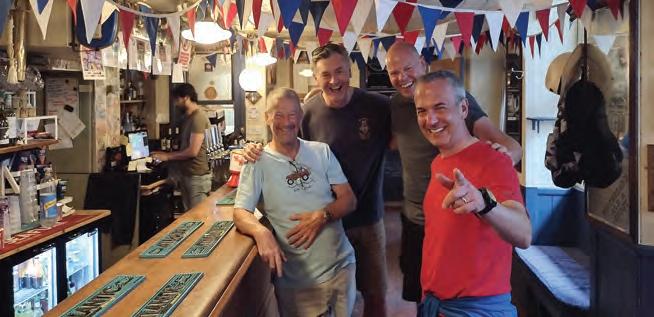

locals celebrated a birthday and had great fun posing for photos, dressed as Vikings.
The beer highlight of our day and a half in the Scillies was on the beautiful, car-free island of Trescoe with its white, sandy beaches. We walked from the ferry’s landing point to the New Inn and drank St Austell Anthem (3.8 per cent), a summery pale ale in good condition. As with many of the places we visited, we left Scilly feeling there was a great deal we hadn’t seen, such as the Turk’s Head on St Agnes, the most southwesterly pub in the UK; and Ales of Scilly, the local brewery. When I emailed the owner, Jennie, she told me that it was a tough market to sell cask on the Scillies, although two of the pubs do regularly support the brewery.
We strolled 20 minutes into town on a sunny evening and loved Treen’s premium bitter Sunbeam (4.8 per cent) at the GBG-listed Boathouse – yet another top local beer. By coincidence, it was the end of Falmouth’s annual Sea Shanty Festival and the town was rocking. We went to heritage pub the Seven Stars which had a big marquee erected for the weekend and joined in with the singing. Puccini’s ‘Nessun Dorma’ made a belting sea shanty!
On stillage were half a dozen cask ales including Bass (4.1 per cent) and Penzance’s Potion No.9 – both struggling
to stay well-conditioned in the heat, but not detracting from the fun atmosphere. On the quay, locals jumped into the harbour, and Firebrand Brewing from Launceston dispensed beer from its stall.
After a day of sailing in fog, this was the last night and was celebrated with a party at crew member Anthony’s house. Five of us borrowed his family’s bicycles and, in biathlon style, cycled the three miles to craft brewery Brew Forest. With a welcoming taproom, blue skies and the sun shining again, we drank its Blonde (4.5 per cent) and Flack Manor’s Wessex Pilsner (4.2 per cent), a fitting way to round off the holiday’s beer hunt. We cycled back for barbecue, a party and the first night in a proper bed for three weeks – bliss!
I swam the next morning in Lymington Sea Water Baths, beautiful in the sun and fresh air, before we sailed back to Port Hamble Marina. I felt sad to have finished the adventure and would recommend a similar experience to anyone. And I am very happy to report an abundance of great real ale and excellent pubs all along the South West coast and beyond.
‘The beer highlight of our day and a half in the Scillies was on the beautiful island of Trescoe’
Pub Heritage Group’s new grading system now has just one inventory which rates pubs at three levels
WORDS: PAUL AINSWORTH IMAGES: MICHAEL SLAUGHTER LRPS
Last year, the Pub Heritage Group unveiled its new grading system for important historic pub interiors. Instead of separate National (for the very best) and Regional (for the next level) Inventories, we now have one with pubs star-rated at three levels. Some former Regional Inventory pubs were evaluated at Three Star level, and we’ve already featured several in previous issues of BEER; here are 10 more.
London accounts for quite a few of these elevations and we start there with the Island Queen, rising proudly above adjacent terraces in a smart area of Islington. Much remains from
late-Victorian refits. The bar area is extraordinary, not least because of its sheer height. Survivals include a two-tier counter, cast-iron Corinthian capitals and a full-height timber and glass screen forming a room on the right. A further glazed screen forms a corridor to the first-floor staircase and note also the Lincrusta ceiling, areas of mosaic flooring and dado panelling.
Across the city in Kensal Rise, the William (formerly William IV) is quite a contrast. A large inter-war pub, probably built by Truman’s, it retains four rooms and many original fittings,
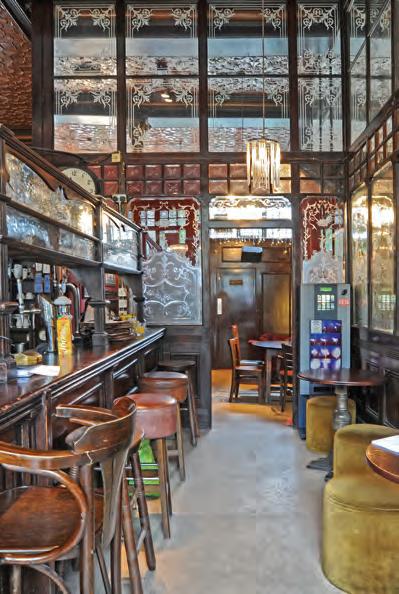
Clockwise from left: Island Queen, Islington, screens give an extraordinary touch to the bar area; William, Kensal Rise, main bar with wood panelling; thatched Plough, Prestbury; Bear, Faversham, private bar
and a recent refurbishment respected its 1930s character. All the rooms have fielded panelling dados (unfortunately painted dark grey) and original fireplaces. A couple of quarter-circle counters are real period pieces and the barbacks are either original or, in the case of the public bar, a faithful replica. Our final stop in the Smoke is south of the river in Kennington. The Old Red Lion is another inter-war pub but in the different style commonly known as Brewers’ Tudor. This aimed to achieve the feel of a half-timbered late-medieval pub, hence the presence of leaded windows, much interior timbering
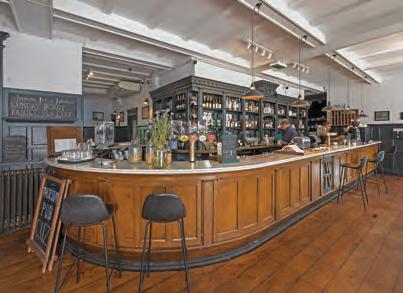
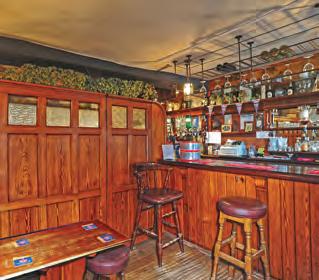

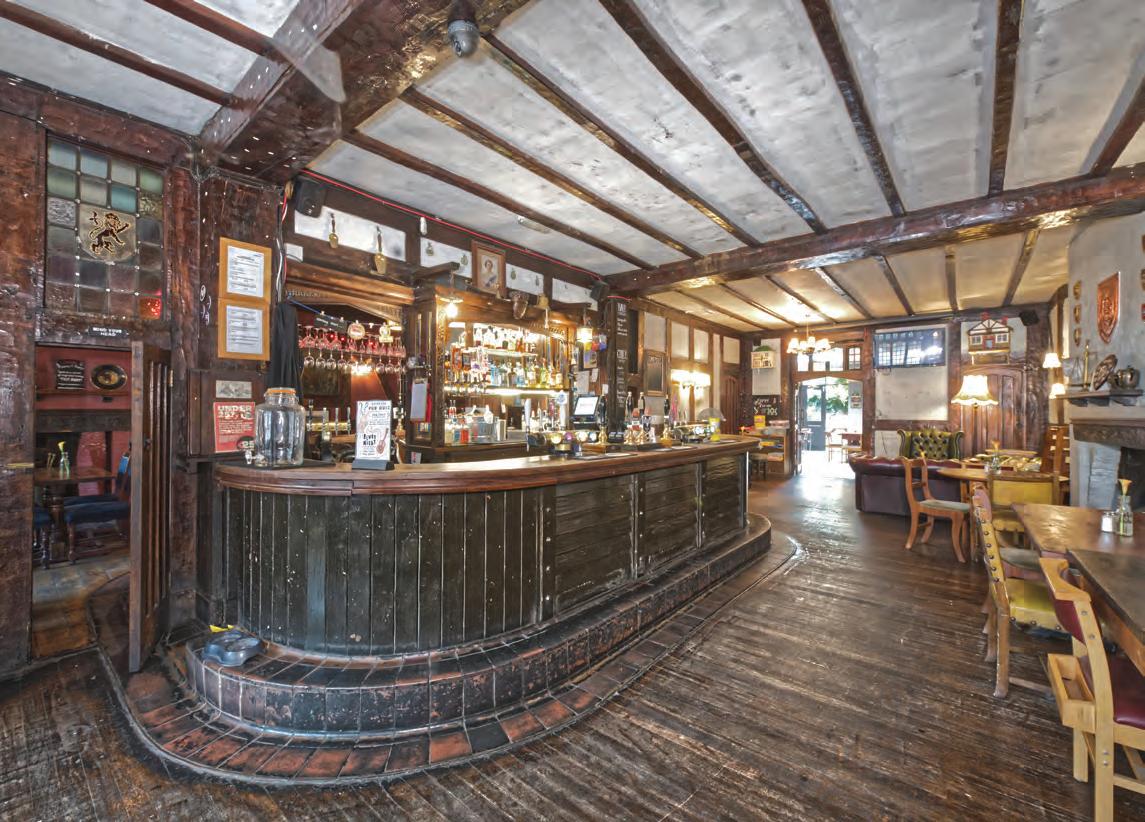

patterned with adze marks and doors of ancient appearance. The central servery has an ornate wooden dividing wall which is a particular delight, and the low, narrow doorways between the bars are a rare feature.
Continuing south, we reach Faversham in Kent where the towncentre Bear can’t be missed. First impressions are of a truly old interior but most of what you see is from 1906, when a fire necessitated much rebuilding and refitting. From the panelled entrance corridor, you can access three partitioned drinking spaces: public bar, snug and private bar. The last area has a lovely barback fitting down the right-hand side.
A long cross-country trip brings us to a personal favourite of mine, the Peyton Arms in Stoke Lyne, Oxfordshire. This wonderfully simple country local is snuggled inside a pair of early 19thcentury stone-built properties and now
comprises a single, unspoilt central bar.
The only significant change to the room since Hook Norton bought the place in 1954 has been installation of a counter in 1962. A couple of other rooms, one the former village shop, are now used just for storage. Interiors of this size and simplicity are, sadly, very rare nowadays.
Heading west, our next stop is the Plough, Prestbury, Gloucestershire. An old thatched pub, it comprises two little-changed rooms and an L-shaped passage. The real star here is the left-hand room with its pale flagstone floor, big stone fireplace, tongue-andgroove wall panelling and fixed bench seating. Enhancing the atmosphere are quoits and an old scorer on the wall, two scrubbed tables and a grandfather clock. It’s one of those magic pub rooms that just works at every level. Service is from a hatch at the end of a passage, with beer served from casks on stillage.
Next, a couple of Midlands pubs, starting in Burslem, Stoke, with the Duke William. A prominent corner-site pub from around 1930, its multi-roomed interior is still largely intact. From the inner lobby, you can choose between the off-sales (created by full-height glazed partition walls) or the public bar where the counter, gantry-style barback, fixed seating and fireplace are all original. Another set of doors accesses the lobby bar with its fabulous full-height, glazed screenwork. Two more rooms lead off the corridor – a front room, fully panelled with bell pushes all round, and the rear room where panelling only survives on one wall. Such a treasure trove of high-quality joinery and glazing is a true delight.
We come now to the Olde Gate Inne at Brassington, a lovely village nestled in the mid-Derbyshire hills. This stone-built pub of 1616 was much altered in 1874 and has changed little since. The main
Strengthen your connection with real ale by part-owning the companies that brew and sell it
Join like minded drinkers who are in the

We started investing in 1989 and now own shares in dozens of breweries and pub companies, from household names to micro breweries
You can download our information pack via our website www.cmic.uk.com or contact us for more information using the details shown below:
bar has a genuinely timeless feel with its pewter mugs hanging from the beams and an old clock ticking away. An inglenook fireplace, quarry-tiled floor, old benches and scrubbed tables complete the picture. The right-hand room has an inter-war parquet floor and is fully panelled, much of the woodwork possibly dating to the 1616 build. On the left, a further room was once a kitchen and entered pub use in the early 1950s.
To the Lancashire seaside resort of Southport for our final English pub. Built in 1909, the Guest House is a very early example of Brewers’ Tudor, but also sports attractive arts and crafts details. The original three-room layout survives with much wood panelling and coloured leaded glass. The glazed, screened counter in the public bar is especially fine, even though some lower panels have been lost. Both this and the front-left room have a wealth of excellent woodwork, while that rear-left has a wide opening to the lobby under a pretty glazed fringe. The barback is modern.
Lastly, to Scotland, and Glasgow to be more precise, and Sloans to be exact. Occupying an early 19th-century courtyard building, this grand city-centre pub was remodelled in 1900, a rich decorative scheme being commissioned by local publican David Sloan. The entrance from Argyll Arcade comprises vestibule and staircase of exceptional quality, with patterned tiles and dado. The ornate staircase continues to the magnificent upper floors where a series of rooms display beautiful timber partitions and ceilings. Although not in regular use, a visit to this part of the pub can generally be arranged. The ground floor is all modern reproduction in Edwardian style, but impressively done.
l For details of all the pubs with historic interiors, visit the Pub Heritage website at pubheritage.camra.org.uk

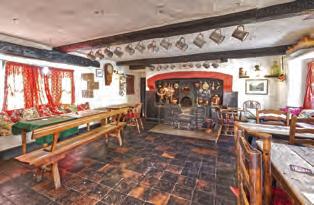
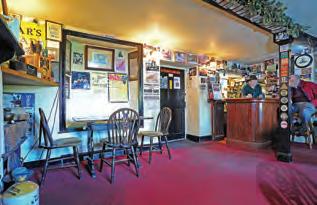


Making alcohol-free beer more available on draught in pubs and bars may help people switch from stronger brews, according to a study published by Bristol University. Would you drink more low- or alcoholfree beer if it was widely available on draught? And if not, why?
Yes, I would, I drink low-alcohol beer which enables me to be social, like if I need to drive, etc. But I drink regular beer if circumstances permit.
Susan Dolan
Not on a regular basis. Experimentation only. I have tried some, both at the bar and once (a while ago) at a tasting panel session. Although they are vastly better than in the past, the main problem for me is the lack of mouthfeel and, particularly if using the stopped fermentation method, a rather overpowering ‘malt drink’ taste. As an aside, if these drinks encourage more people to go to the pub, that can only be a good thing.
Steven Thompson
Yes, I certainly would. There are occasions when drinking any sort of alcohol is unwise – driving and for medical reasons. Mind you, I have never seen any in my local pubs; in fact, I’ve only seen it on ITV’s Coronation Street
Graham Lam
I enjoy good low/no beers. It’d be great if every pub had one on draught.
Martin Collinge
If there is a decent (and independent) one available, I drink them in gig venues when I’m driving. When I’ve been on a big night out at a pub that’s got one on draught, I’ve been known to sneak one or two AF pints in to remain social but reduce the effects both on the night and the morning after.
John O’Donnell
Yes, particularly if more lower alcohol (say under 3 per cent) cask beers were available.
Ben Wilkinson
If I could have a low-/no- alcohol ale which tasted as good as the real thing, I’d definitely drink it and so would many of our members.
Out here in the wilds of Pembrokeshire, the nearest real ale pub can be miles away, not on a public transport route or on a road with no traffic after about 6 o’clock in the evening, meaning it’s drive or go dry. To be able to drink four or five pints and still be under the limit would do wonders for our social lives. I’m sure the same is true in many, if not most, rural areas.
Jon O’Brien
On a normal pub visit no, I find them in general lacking body and well, rather lightweight, as you would expect, but if needs must, I would – better than sipping on a coke.
Michael Ayres
I’d probably not drink them regularly in a pub. I tend to prefer stouts and stronger-flavoured bitters which don’t translate well into low/no. I might drink a lowalcohol beer if I was driving – lunch on a long journey, for example.
James Williams
All comments are taken from a discussion on CAMRA’s online forum at discourse.camra.org.uk
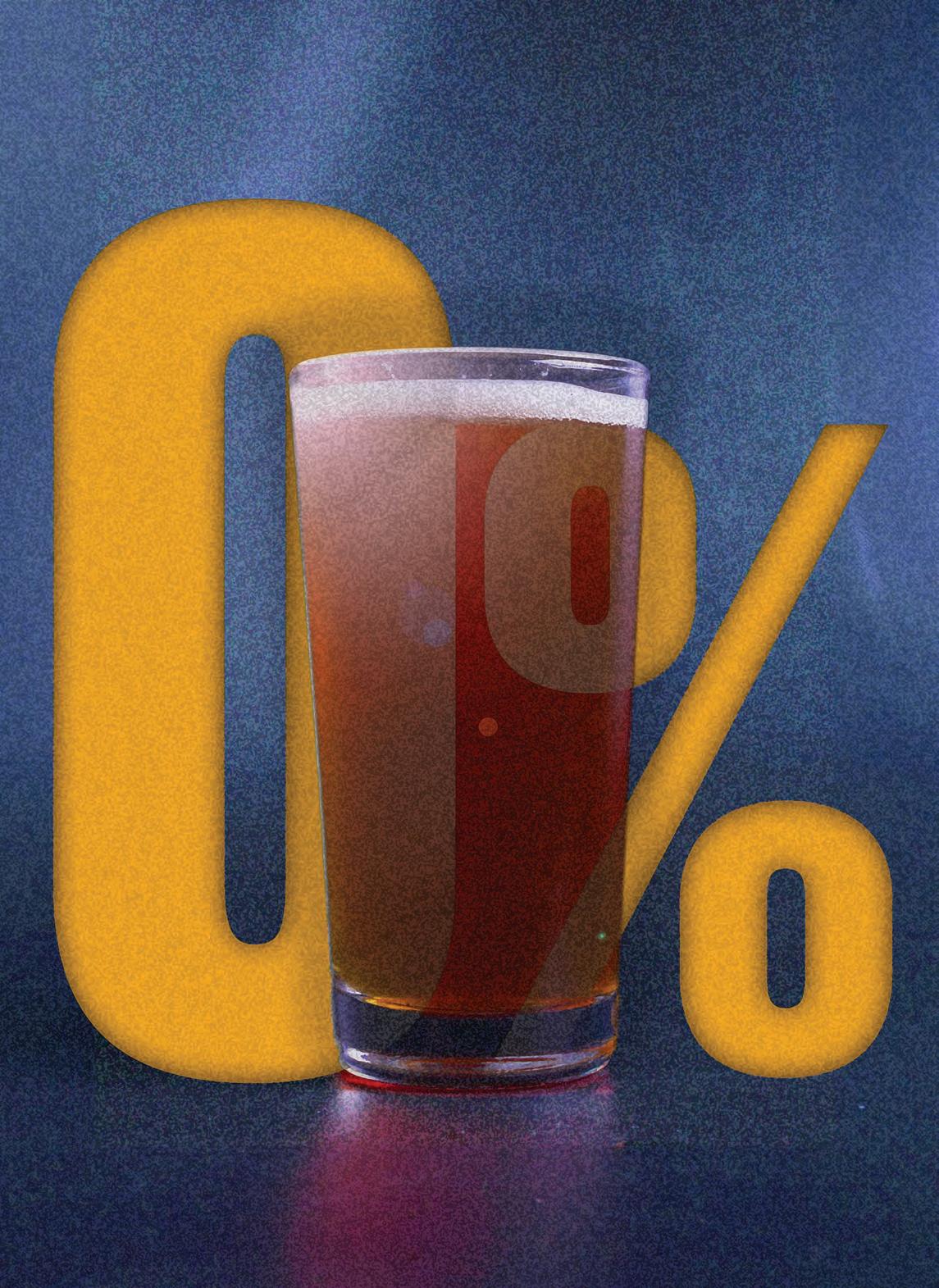

CAMRA has launched a campaign to raise awareness of Carlsberg Marston’s Brewing Company’s (CMBC) Fresh Ale concept, which sells keg versions of three of its cask beers through handpumps – long associated with real ales.
So far, CMBC has Wainwright Gold, Wainwright Amber and Hobgoblin IPA, which will have ‘brewery conditioned beer’ on the pump clip, in the Fresh Ale line-up.
CAMRA believes the Fresh Ale idea has worrying implications for both cask beer and consumers. Most noticeably through misleading dispense, but also a more general threat to the real ale category as the beer is not cask-conditioned, but the use of Fresh Ale marketing seeks to imply that it is.
The campaign has kicked off with a letter to the chair of Trading Standards Lord Bichard, from CAMRA national director and chair of its Real Ale, Cider and Perry Campaigns Committee, Gillian Hough.
CAMRA national chairman


Nik Antona said: “Misleading dispense is particularly detrimental to beer drinkers, as hijacking a handpump to serve a keg beer removes a genuine cask product from the bar, reducing choice of different formats for consumers.
“We hope Trading Standards bodies across Great Britain will take swift, coordinated national action to address misleading beer dispense





CAMRA launches campaign to raise awareness of misleading beer dispense
and safeguard the handpump as an indicator of cask beer.”
let
Fresh Ale using the ‘Send an email to at of venue
CMBC has yet to cancel its plans despite CAMRA warning pubs stocking the beer may be excluded from next year’s Good Beer Guide. CAMRA members are being encouraged to get involved. They can let CAMRA know if they come across Fresh Ale by using the ‘Send an email to the CAMRA branch’ button at the bottom of the relevant WhatPub venue page.

Members are also being encouraged to send photos of Fresh Ale pump clips and email them to campaigns@ camra.org.uk. Finally, if in doubt, Ask if it’s Cask. The campaign needs consumers to make licensees aware of the issue of misleading dispense and explain why CAMRA members won’t be buying it.
After writing to Lord Bichard, the next steps for the Campaign involve contacting MPs and the Department of Business and Trade to ask for political support in urging Trading Standards to act. The Handpump Hijack campaign hopes to ensure consumers are well informed about Fresh Ale and aren’t being duped. The goal is to stop the product from being served in its current form.
Find out more about the Handpump Hijack campaign at camra.org.uk/take-action/ handpump-hijack



As CAMRA’s Members’ Weekend visited Dundee again this year, I’m devoting this page once more to Scotland, which currently boasts some of the most interesting and exciting new breweries in Britain. Regrettably few of them, though, have shown much interest in those distinctively Scottish traditional styles, the richly malty ‘shilling ales’ at various strengths that evolved from 19th-century milds, still ubiquitous in the late 20th century, but since in worrying decline. So, I was delighted to find a couple of very good craft interpretations, including a rare lowstrength Muncie’s 60/- (3.4 per cent ABV) from Dookit in Tollcross, Glasgow.
A dookit is a dovecote or, by extension, any small cupboard-like space, which indicates the scale on which Harry Weskin has operated since upgrading from cuckoo to production brewer in 2022. The dark brown beer has a tarry dark, but not roasted, malt aroma with a hint of berry, and a suggestion of modern piny hop flavour and rosemary on a rich, full Dundee cake palate and biscuity finish that remains refreshing.
It’s currently conditioned in dinky 330ml bottles, but may shift to cans.
Wasted Degrees in Blair Atholl, Highland Perthshire, has been producing a wide and often-changing range of styles, including traditional ones, since 2016, using entirely renewable energy. Its 80/- (5.5 per cent, unpasteurised can) is deep amber with a pungently malty aroma, a toasty shortbread palate with orange and caramel notes, and a clean drying finish with gentle toffee and just a hint of roast. Its subtleties are emphasised by restrained cask-like carbonation. The brewery also makes a stronger 90/- ‘wee heavy’.




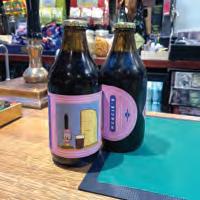
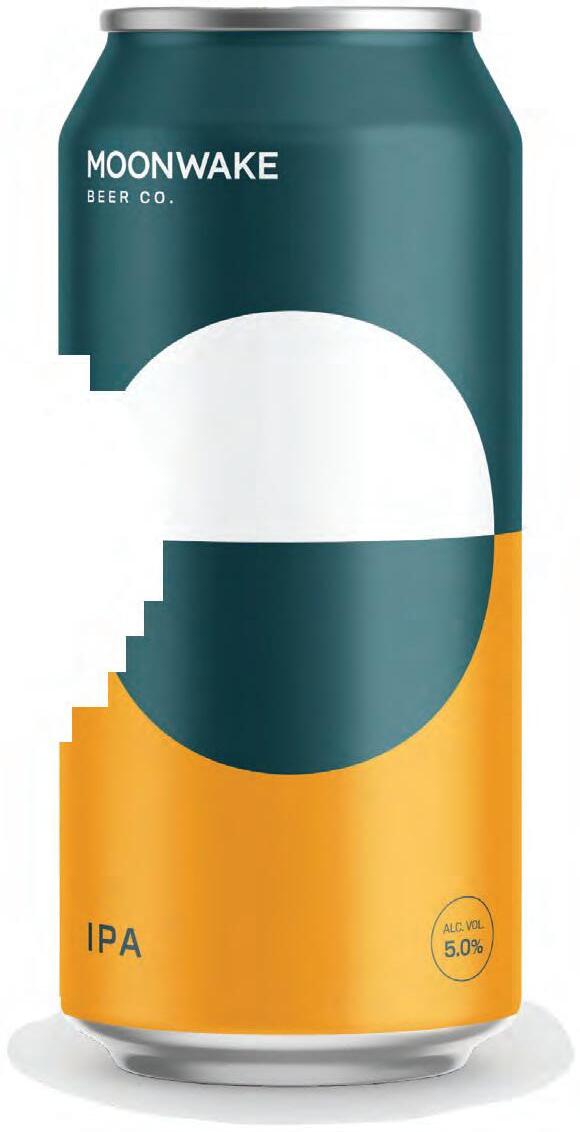

Mòris Gaelic for great or large, so the like-named brewery, opened in 2012 at Kellas near Dundee, has set itself high standards. Its session IPA Stand-Up (4.2 per cent), pleasingly bottle-conditioned rather than canned, doesn’t disappoint; a vivid mango ice cream aroma on this lively beer heralds a tasty palate with passion fruit, lemon, lime and floral rose notes with a finely bitter and lightly fruity finish.

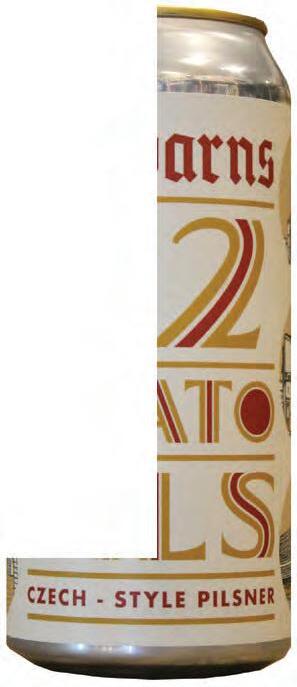
Moonwake IPA (5 per cent, unfiltered can) is hopped with US Chinook, Lemondrop, Mosaic and Southern Cross from New Zealand, also the origin of head brewer Vinny Rosario. It has all the mango and pine you’d expect, with softer notes of strawberry and peach emerging on a decent malt base, and a beautifully balanced peppery, zesty finish. The brewery, founded in 2021, gets its name
from the moon’s reflection on the nearby waters of Edinburgh’s port, Leith. Just along Leith Walk towards the city centre is one of Scotland’s most impressive new breweries, Newbarns, created in 2020 by four friends who had previous form at places like London’s Kernel. It particularly impresses with its unpasteurised craft lagers made with a traditional decoction mash, like Czechstyle 12 Plato Pils (5 per cent), using Haná Moravian heritage malt and noble Czech and German hops. The gold beer has a bready, floral-tinged aroma, a sweetish palate already developing a herbal bitterness, and suggestions of peaches and cream in the finish: a treat. l Most beers were sourced from the Wee Beer Shop in Glasgow, which also offers mail order: weebeershop.co.uk. I paid the going rate for all samples.

de Moor is one of the country’s leading writers on bottled beer, and author of Cask: The real story of Britain’s unique beer culture (2023). Follow him at @desdemoor and read more from him at desdemoor.co.uk
DesSam O’Leary, a comedian and filmmaker who has worked on shows such as Inside No. 9 and Don’t Hug Me I’m Scared, talks through his time getting fired from pubs
Unlike many stand-up comedians, I haven’t endured the room-above-a-pub comedy circuit, so I quite like pubs. Most of my non-comedy jobs have been in pubs, actually. The only experience of that kind of audience I’ve had was with my comedy night Adult Film Club, which I do with Chris Cantrill. We ran it for the BBC in Cardiff, with free tickets. I think nearly everyone who came along saw the name Adult Film Club and thought we were going to be showing a different kind of adult film, so they were a bit disappointed when it was just a load of comedy videos and decided to heckle every film. I didn’t think people heckled films. I used to work in what’s still my favourite pub, the Cross Keys in Siddal, Halifax. I got fired from there and I still go there when I can because I love it. No tellies, mirror or clocks. A fireplace and a lovely pub dog. Always a great selection of good beers, too.
I don’t tend to drink lager or naff watery beer, so I really appreciate a decent pint. I don’t have it very often, but one of my favourite beers is probably Plum Porter; it’s like a drinking pudding. Bread & Butter by Vocation is brilliant, too. Basically, if it tastes really rich and far too indulgent, I’m drinking it.
I always got hired to work in pubs because I’m a magician sounds like a joke, but isn’t. So, pubs would think, ‘Oh, excellent, he can do some tricks if we get bored’. I used to work as a professional magician, but dreaded doing pub gigs. Often it would be awful, because there’s something about magic that brings out the worst in some middle-aged men. They act like you’re trying to trick them into thinking you’re actually magic. Desperate to not enjoy it, so of course, they don’t. Now I tend only to do magic for friends or sometimes on stage. I got hired to work behind the bar at a pub in Halifax (because I said I was a magician) that will remain nameless. I’d worked in pubs but never behind the bar before. I came in for a trial shift and it quickly became apparent to the owner that I was bad at pulling pints. Instead of teaching me, they said: “Go and do some tricks for that table over there”. It was a family having dinner, and they
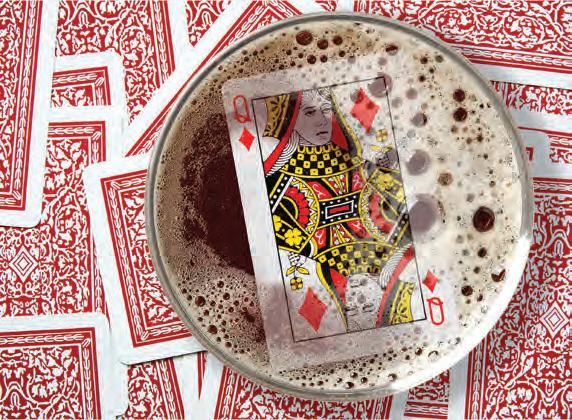
“I used to work as a professional magician, but dreaded
doing pub gigs”
really enjoyed my daft little routine. At the end of their meal, the dad put £20 in my hand and said: “That’s for you, we loved that.”
When I took the 20 behind the bar as the family were leaving, the owner swiped it off me and said: “We don’t really do tips like that, mate. Everything is shared out at the end of the week.” I mentioned that the guy said it was for me, but he was insistent, so I dropped it. The next day, when I asked about my next shift, he’d blocked my number. So I never got paid for the shift or the magic. In fact, I’d technically paid him. I think he makes a living by churning through vulnerable teenage magicians.
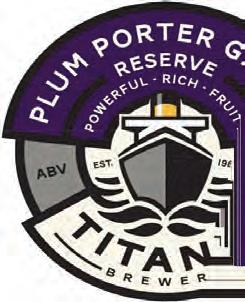
I’ve been working with Tom Lawrinson on some comedy films we stick online. We did a Gordon Ramsay parody, where he’s being overly critical of everything in a restaurant. We filmed some of it in a Wetherspoon. I was dressed in chef whites and had to barge out of the toilet and shout in an outraged voice: “There’s someone pooing in there!” We did it over and over again. Nobody knew what we were doing. Once we finished shooting we sat down and had a meal there. Nobody said anything to us. I think because of the chef’s whites they assumed I worked in the kitchen and was having a breakdown.
Brewery numbers continue to decline
Burton unions head off to Bakewell
Drinks writer is our top campaigner Desi Pubs the movie makes its debut
KEEP UP TO DATE with all the What's Brewing news, events and campaigns on our website, wb.camra.org.uk
• Badenoch urged to halt handpump hijack
CAMRA has written to business secretary Kemi Badenoch urging her to step in to stop Carlsberg Marston's Fresh Ale handpump hijack.
In the letter, the Campaign explains that National Trading Standards has said it doesn't have the powers to investigate the Fresh Ale concept launched by Carlsberg Marston's Brewing Company, which involves serving filtered and kegged beer through

CAMPAIGNS, NEWS AND VIEWS
handpumps usually used exclusively for caskconditioned beer.
This is despite its predecessor agency, the Local Authority Coordinating Body on Trading Standards (LACOTS), carrying out a similar investigation in the 1980s.
The investigation by LACOTS found that using handpumps to dispense kegged beer was misleading to consumers and issued advice to all local Trading Standards officers.
The Campaign has also submitted a formal
complaint to West Northamptonshire Trading Standards, which is believed to have a primary authority agreement with Carlsberg, the global brewer forming just over half of the CMBC joint venture.
In the letter to Badenoch, CAMRA's real ale, cider and perry campaigns director
Gillian Hough said: "The impact of this perniciously misleading form of dispense will affect the reputation and availability of caskconditioned beer in all pubs. It is a self-evident fact that consumers should be as fully informed as possible about the product they are buying at the point of dispense."
CAMRA is calling on the was bulldozed last August. allowed to happen again, government to throw its
The story highlighted the and stronger planning support behind a law drastic need for better enforcement must be calling for better protection planning enforcement laws implemented to prohibit for pubs in the wake of the to protect pubs in the UK any more vital, historic Crooked House scandal. CAMRA's pub and club pubs being lost.
The Heritage Pubs Bill campaigns director Gary "We are also was presented to the House Timmins said: 'We welcome campaigning for the of Commons by Dudley this proposal. After the Scottish and Welsh South MP Marco Longhi deliberate destruction of governments to strengthen and has been inspired by the the Crooked House, great their laws so that destruction of the 18th-work has been done to demolition or conversion of century Crooked House order the reconstruction, a local always requires (right), in Himley, which but this must never be planning permission."

• Community hub scoops the Rising Sun opening its community banded together CAMRA pub saving crown doors again for business in to ensure the White Horse October 2022. was safe from developers A COMMUNITY, which Within one month of the intent on turning it into raised more than £350,000 community share option housing. The pub is now to save the Rising Sun in being launched, £350,000 operating as a pop-up until Woodcroft, Chepstow, has had been raised from 240 the new year, while won CAMRA's 2023 Pub investors. Once given the extensive work takes place. Saving Award. keys to the pub, the Three pubs were highly
The Save Our Sun group community made a commended: worked for a decade to save herculean effort to repair • George in Bethersden, the pub and to provide a and refurbish the building. Kent. Saved by the George community hub. The pub is now the centre of Community after closing
The Rising Sun appears its community. It is during the pandemic, and on OS maps from 1870 and dog-friendly, serves food as now runs as a wet-led pub was brewery-owned in 2011 well as providing space for at the heart of the village until high rents and beer volunteer activities. • Raven Inn in Glazebury, costs caused its doors to This year's runner up is Warrington. Campaigned close. Despite the the White Horse in for by the Save the Raven community being informed Stonesfield, Oxfordshire. Group and backed by more it had been bought as a pub The pub garnered support than 1,200 supporters to in late 2012, it transpired from across the pond, restore it to its former glory the new owner was a grabbing headlines in the • Travellers Rest in Skeeby, developer which wanted to New York Times and the North Yorkshire. This turn it into residential. Canadian Broadcasting opened its doors for the first
This led to a community- Corporation, with funding time in almost 15 years led campaign to buy the coming from the US as well after being saved from pub. Started by a few locals as the local area. becoming a victim of in early 2013, the campaign As the last remaining pub redevelopment by a finally reached fruition with in the village, the property developer.
NEW figures saw the UK brewing industry post a 38 net closure rate across the UK since 2023, with all regions either seeing a cut or remaining the same.
The figures released by the SIBA UK Brewery Tracker show the UK total number of active brewers now stands at 1,777. The year-on-year comparison shows a slightly more positive picture, with some regions seeing overall growth when compared to this time in 2023. The East has had a particularly strong 12 months with a plus 11 net growth rate, with the South East (up three) and South West (up two) also seeing growth.
The overall UK year-onyear figure is also down 4 7, led primarily by a 19 net loss in the North West, 12 in the North East, and 11 in Wales and the Midlands.
SIBA chief executive Andy Slee said: "Seeing a two per cent drop in the number of breweries in the UK is a small shift, but not the start to the year the industry had hoped for, and as we look ahead to what promises to be a busy summer for pubs, I'm hopeful we'll see the dial swing into the positive as we did in Q2 2023.
"There is no single reason breweries in the UK close, but for most it is a combination of rising costs and slowing sales caused by the cost-of-living crisis."
Part of the Burton union system is to be relocated to Thornbridge brewery's Bakewell site
• New lease of life for has also provided guidance Thornbridge head brewer redundant brewing system on maintenance and set-up Rob Lovatt said: ''While for the system at there are challenges yet to PART of Carls berg's Thornbridge, which is set to get the system up and (CBMC) Burton union be completed in May. running, we're thrilled to system is to be relocated The sets will be used for have the opportunity to from Burton-upon-Trent to special-edition cask beers preserve these beautiful the Thornbridge brewery. using this method created in icons of British brewing."
The two breweries have Burton in the 19th century CMBC has invested in partnered to establish a to collect excess yeast. the preservation of the union system in Bakewell, CMBC head of brewing remaining union sets at using redundant sets from Emma Gilleland said: "This Marston's, which will be on Marston's brewery. collaboration is a perfect display to celebrate the
Discussions between showcase for the ways brewery's heritage and the CMBC and Thornbridge brewers can come together system's history. It is began in February. CMBC to deliver something expected that the gifted the set of union special, for Britain's preservation work will be barrels to Thornbridge and incredible brewing heritage. completed by the summer.
CAMPAIGNERS fighting to save one of Manchester's CAMRA's Central Manchester branch has reaffirmed its continued support for the management team and staff at the Grade II-listed Britons Protection (BP) pub, which is facing two unwelcome changes.
Owner Heineken's Star Pubs wants to take the pub back from the leaseholders, plus a proposed property development will enclose the historic building.
Branch pub preservation officer Steve Ingham said: "If the BP is taken back by Star, the nature and spirit of this facility will evaporate for a potentially homogeneous offering of the same old culprits in terms of the drink offer."
The pub has set up a crowdfunding page to help defray its legal costs in its fight with Star at justgiving. com/crowdfunding/ savethebritonsprotection
BREWING industry administration, the deal will allow investment in founder and MD Todd veteran Rupert Thompson will see brewing continue the taproom plus sales Matteson. Hogs Back will has agreed an investment at Mondo's London site. and marketing. support Mondo in areas deal with Mondo, which As well as delivering a Thompson, owner of such as packaging and secures the future of its fresh injection of capital TEA brewer Hogs Back, marketing, while the latter brands, as well as its for the Mondo brands becomes chairman of a new will be the exclusive brewery and taproom in including Dennis Hopp'r, company, Mondo Beer, distributor in London of Battersea, London. Road Soda and Little working to support the beers from Hogs Back's
Following a

JOURNALIST and author
Laura Hadland was crowned CAMRA's top campaigner at its Members' Weekend, AGM and Conference in Dundee. Her nomination included a long list of achievements this year, particularly her commitment to inclusiveness, responsible drinking and her work championing small producers and venues.
Laura (right) was a key voice in calling national attention to the destruction of the Crooked House through her blog, interviews about pub protection for radio stations across the country, and on social media. The Crooked House case began in August oflast year, when the famously wonky 260-year-old pub near Himley in the West Midlands was heavily damaged in a fire and then abruptly bulldozed without authorisation by its new owner. Through Laura's campaigning, more people were made aware of this scandal and in February the owner was ordered to rebuild the pub.
Her nomination also praised her award-winning book, 50 years of CAM"RA, where members' stories and memories of the Campaign were recorded. The nominator highlighted that this research preserved oral histories which would otherwise have been lost.
The award also recognised her championing of cask beer, introducing it

to new audiences through her advocacy, and by hosting beer tastings including the first dedicated cask tasting at Ludlow Slow Food Festival last summer. She is also a beer judge for national and international competitions, including the Champion Beer of Britain, SIBA and Great Taste awards.
CAMRA awards director Laura Emson said: "Laura was the clear winner, even with all the other fantastic nominations this year. Her campaigning has been a fantastic help in raising awareness for the Crooked House scandal as well as
honour on me. It's just wonderful how I've been welcomed into the CAMRA community. Back in 2019, when I first got the commission to write 50 Years ofCAM"RA, I never expected that my involvement would really become so all consuming, but it's just a huge part of my life now. I think because the CAMRA ethos, the support for cask ale, for pubs and for independent brewers is something that's a huge focus for me as well.
consistently putting her voice out there via local radio stations to help protect our pubs.
"It's a pleasure to formally recognise her hard work and dedication to making sure pubs are protected in this most challenging of times for the industry.
"This award is a testament to the positive impact that Laura has had on the industry, and I look forward to seeing her work in the years to come."
Accepting the award, Laura Hadland said: "Just got to say a huge thank you for bestowing this amazing
"It is fantastic to be a part of writing regularly for What's Brewing and BEER, but also, despite all the research that I did, no one warned me to not make eye contact with my branch chair when they were looking for volunteers. So now I am on the ground as well, helping out with my branch, volunteering nationally, doing things like the Learn & Discover bar at GBBF (Great British Beer Festival), which I will be sad to miss this year's.
"I hope that we can all keep spreading the good word about cask ale.
"I am trying really hard to help keep pub heritage in the public eye.
"I think there is loads of great work we can all continue to do, and it's really, really kind that you've recognised the work that I have been doing up until now.
"I hope that all of you within CAMRA keeps supporting diverse voices talking about great beer."
DESI: A Pub Story, a documentary directed by Zaki Solosho made for CAMRA's Learn & Discover platform, made its debut at the Campaign's Members' Weekend and Conference.
The film is a fascinating guide to British-Indian pubs and a celebration of our modern multi-cultural
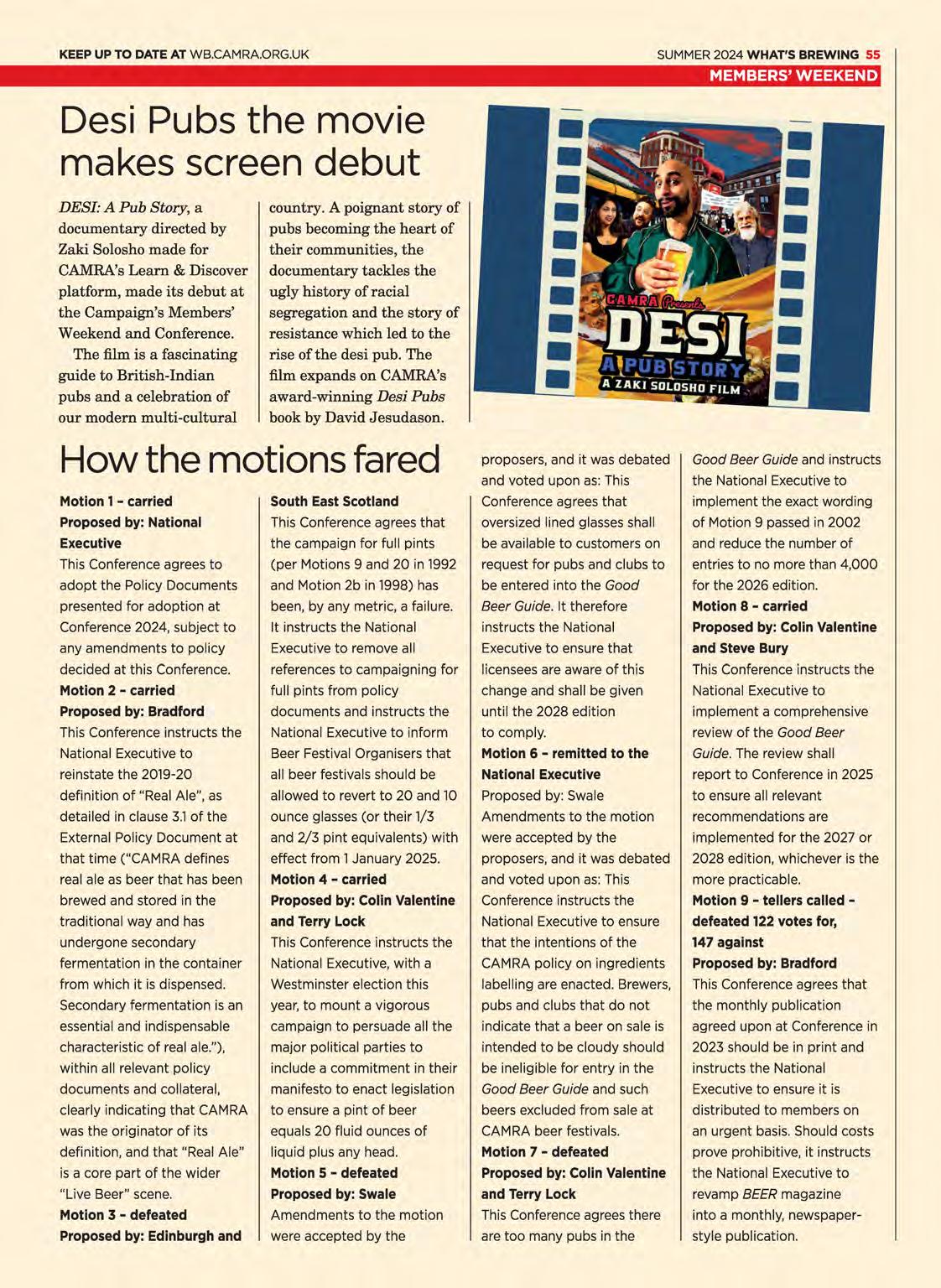
country. A poignant story of pubs becoming the heart of their communities, the documentary tackles the ugly history of racial segregation and the story of resistance which led to the rise of the desi pub. The film expands on CAMRA's award-winning Desi Pubs book by David Jesudason.
Motion 1 -carried
Proposed by: National Executive
This Conference agrees to adopt the Policy Documents presented for adoption at Conference 2024, subject to any amendments to policy decided at this Conference.
Motion 2 -carried
Proposed by: Bradford
This Conference instructs the National Executive to reinstate the 2019-20 definition of "Real Ale", as detailed in clause 3.1of the External Policy Document at that time ("CAM RA defines real ale as beer that has been brewed and stored in the traditional way and has undergone secondary fermentation in the container from which it is dispensed. Secondary fermentation is an essential and indispensable characteristic of real ale."), within all relevant policy documents and collateral, clearly indicating that CAMRA was the originator of its definition, and that "Real Ale" is a core part of the wider "Live Beer" scene.
Motion 3 -defeated
Proposed by: Edinburgh and
This Conference agrees that the campaign for full pints (per Motions 9 and 20 in 1992 and Motion 2b in 1998) has been, by any metric, a failure. It instructs the National Executive to remove all references to campaigning for full pints from policy documents and instructs the National Executive to inform Beer Festival Organisers that all beer festivals should be allowed to revert to 20 and 10 ounce glasses (or their 1/3 and 2/3 pint equivalents) with effect from 1 January 2025.
Motion 4 -carried
Proposed by: Colin Valentine and Terry Lock
This Conference instructs the National Executive, with a Westminster election this year, to mount a vigorous campaign to persuade all the major political parties to include a commitment in their manifesto to enact legislation to ensure a pint of beer equals 20 fluid ounces of liquid plus any head.
Motion S -defeated Proposed by: Swale Amendments to the motion were accepted by the
implement the exact wording of Motion 9 passed in 2002 and reduce the number of entries to no more than 4,000 for the 2026 edition.
Motion 8 -carried
Proposed by: Colin Valentine and Steve Bury
proposers, and it was debated Good Beer Guide and instructs and voted upon as: This the National Executive to Conference agrees that oversized lined glasses shall be available to customers on request for pubs and clubs to be entered into the Good Beer Guide. It therefore instructs the National Executive to ensure that licensees are aware of this change and shall be given until the 2028 edition to comply.
Motion 6 -remitted to the National Executive Proposed by: Swale
Amendments to the motion were accepted by the proposers, and it was debated and voted upon as: This Conference instructs the National Executive to ensure that the intentions of the CAMRA policy on ingredients labelling are enacted. Brewers, pubs and clubs that do not indicate that a beer on sale is intended to be cloudy should be ineligible for entry in the Good Beer Guide and such beers excluded from sale at CAMRA beer festivals.
Motion 7 -defeated
Proposed by: Colin Valentine and Terry Lock
This Conference agrees there are too many pubs in the
This Conference instructs the National Executive to implement a comprehensive review of the Good Beer Guide. The review shall report to Conference in 2025 to ensure all relevant recommendations are implemented for the 2027 or 2028 edition, whichever is the more practicable.
Motion 9 -tellers calleddefeated 122 votes for, 147 against
Proposed by: Bradford
This Conference agrees that the monthly publication agreed upon at Conference in 2023 should be in print and instructs the National Executive to ensure it is distributed to members on an urgent basis. Should costs prove prohibitive, it instructs the National Executive to revamp BEER magazine into a monthly, newspaperstyle publication.
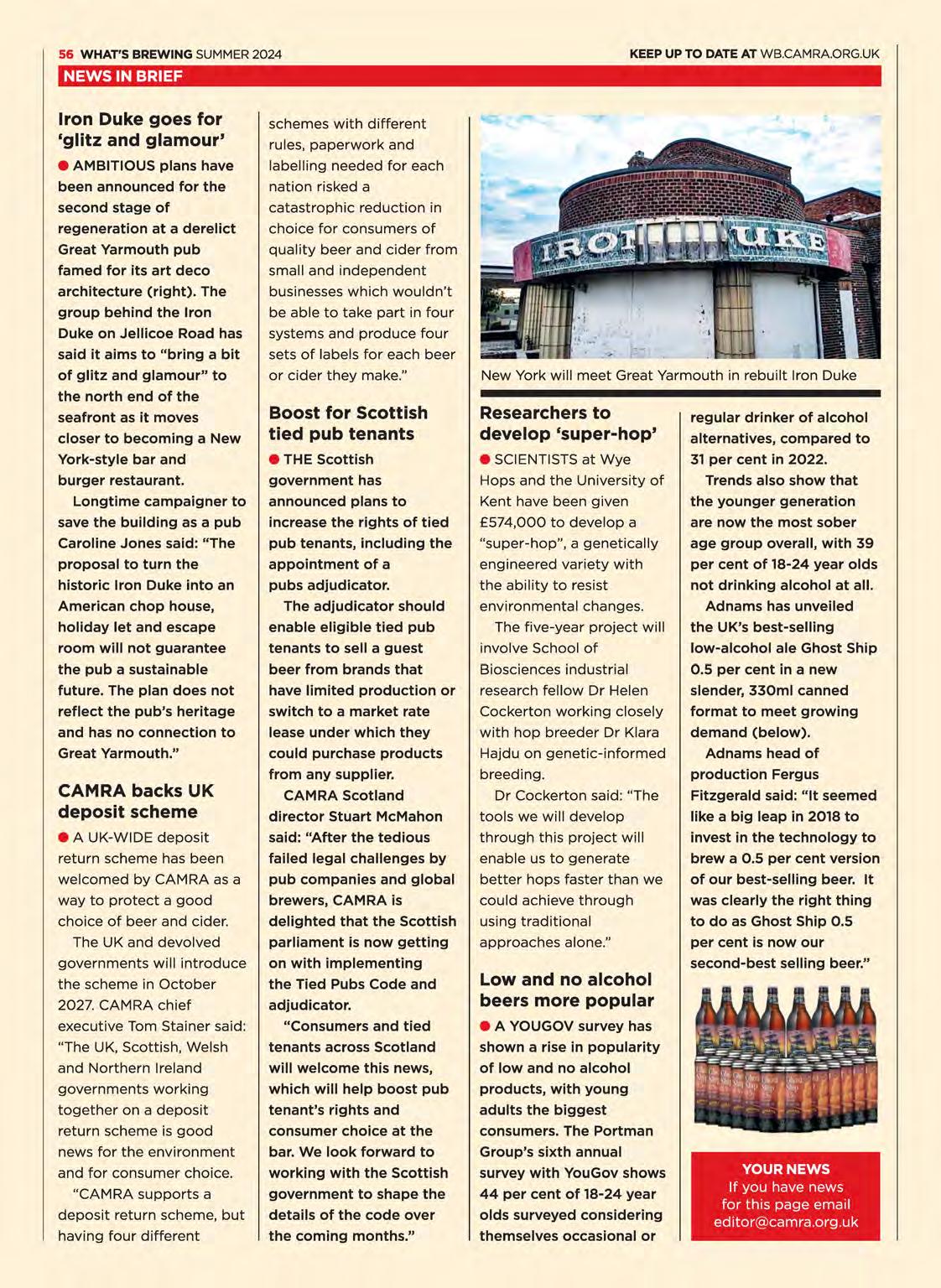
e AMBITIOUS plans have been announced for the second stage of regeneration at a derelict Great Yarmouth pub famed for its art deco architecture (right). The group behind the Iron Duke on Jellicoe Road has said it aims to "bring a bit of glitz and glamour" to the north end of the seafront as it moves closer to becoming a New York-style bar and burger restaurant.
Longtime campaigner to save the building as a pub Caroline Jones said: "The proposal to turn the historic Iron Duke into an American chop house, holiday let and escape room will not guarantee the pub a sustainable future. The plan does not reflect the pub's heritage and has no connection to Great Yarmouth."
e A UK-WIDE deposit return scheme has been welcomed by CAMRA as a way to protect a good choice of beer and cider.
The UK and devolved governments will introduce the scheme in October 2027. CAMRA chief executive Tom Stainer said: "The UK, Scottish, Welsh and Northern Ireland governments working together on a deposit return scheme is good news for the environment and for consumer choice.
"CAM RA supports a deposit return scheme, but having four different
schemes with different rules, paperwork and labelling needed for each nation risked a catastrophic reduction in choice for consumers of quality beer and cider from small and independent businesses which wouldn't be able to take part in four systems and produce four sets of labels for each beer or cider they make."
e THE Scottish government has announced plans to increase the rights of tied pub tenants, including the appointment of a pubs adjudicator.
The adjudicator should enable eligible tied pub tenants to sell a guest beer from brands that have limited production or switch to a market rate lease under which they could purchase products from any supplier.
CAMRA Scotland director Stuart McMahon said: "After the tedious failed legal challenges by pub companies and global brewers, CAMRA is delighted that the Scottish parliament is now getting on with implementing the Tied Pubs Code and adjudicator.
"Consumers and tied tenants across Scotland will welcome this news, which will help boost pub tenant's rights and consumer choice at the bar. We look forward to working with the Scottish government to shape the details of the code over the coming months."
e SCIENTISTS at Wye
Hops and the University of Kent have been given £574,000 to develop a "super-hop", a genetically engineered variety with the ability to resist environmental changes.
The five-year project will involve School of Biosciences industrial research fellow Dr Helen Cockerton working closely with hop breeder Dr Klara Hajdu on genetic-informed breeding.
Dr Cockerton said: "The tools we will develop through this project will enable us to generate better hops faster than we could achieve through using traditional approaches alone."
e A YOUGOV survey has shown a rise in popularity of low and no alcohol products, with young adults the biggest consumers. The Portman Group's sixth annual survey with YouGov shows 44 per cent of 18-24 year olds surveyed considering themselves occasional or
regular drinker of alcohol alternatives, compared to 31 per cent in 2022.
Trends also show that the younger generation are now the most sober age group overall, with 39 per cent of 18-24 year olds not drinking alcohol at all.
Adnams has unveiled the UK's best-selling low-alcohol ale Ghost Ship 0.5 per cent in a new slender, 330ml canned format to meet growing demand (below).
Adnams head of production Fergus Fitzgerald said: "It seemed like a big leap in 2018 to invest in the technology to brew a 0.5 per cent version of our best-selling beer. It was clearly the right thing to do as Ghost Ship 0.5 per cent is now our second-best selling beer."

• Fears for future of Southwold brewery
I OFTEN think about Adnams beers with fondness, writes Matthew Curtis (pictured). The Southwold-based brewer has a knack for making delicious cask ales with a rich barley malt and yeast-led character; forest fruits and malt loaf wrapped up with a moreish, peppery bitterness. It's a quality that has you contemplating a return to the bar just moments into your pint, found in multitudes within beers like Southwold Bitter, Gunhill Ruby Mild, and the irreplaceable Broadside. Although Adnams might be better known today for beers such as its Citrahopped pale ale, Ghost Ship, it's the hold its darker beers have over me that has, like with many others, enamoured this brewery to me. It's also why when I read in February 2024 that the brewery was seeking investment that I felt some minor cause for concern. However, I wasn't too worried, as Adnams chief executive Andy Wood was quoted in the Eastern Daily Press as saying the business had a "healthy balance sheet" and wasn't seeking an outright sale.
This mood quickly shifted, as by the end of March Sky News was reporting that the 134-year-
old brewery -which also operates a distillery and as a wine merchant -was now seeking a potential buyer. It was also reported that Wood is to stand down this coming June, with current finance chief Jenny Hanlon stepping into the role. The brewery's long-standing chair, Dr Jonathan Adnams, told Sky that the 25 per cent decline in the size of the cask beer market since 2019 is to blame for its struggles. Adnams also operates 45 managed and tied public houses, and in the first half of its current financial year posted operating losses of £2.4m, based on a £30m turnover.
It is a rough time for beer makers, with a reported 69 breweries closing in 2023 according to a report published in The Drinks Business -an 82 per cent year-on-year increase. Rampant inflation, rising business rates and less spending money in consumers' pockets have made for difficult trading conditions. Two prominent Yorkshire breweries, Black Sheep of Masham and North of Leeds, have both recently been saved from administration by new parent companies. London's Meantime brewery was recently closed by Asahi, with production moving to sister brewery, Fuller's.
And yet, despite the challenging conditions the beer industry finds itself
facing, some brewery owners remain stoic. Taking to X (formerly Twitter) William LeesJones of the Manchesterbased JW Lees brewery states the family business finished its current financial year with record sales of £94.3m, up 10 per cent on its 2023 figures.
Like Adnams, Lees owns a large estate of leased and managed pubs -in this instance 150 -but also seems to have the required nous to navigate current trading circumstances.
"It's tough running pubs," Lees-Jones said in his post. "Costs are through the roof, even more so with business rates and wages this week. But people love beer and pubs."
In an effort to stave off further rot, at the beginning of the month Adnams unveiled what might be considered as a dramatic rebrand. The once bold and high contrast, colourful designs that previously adorned its labels have
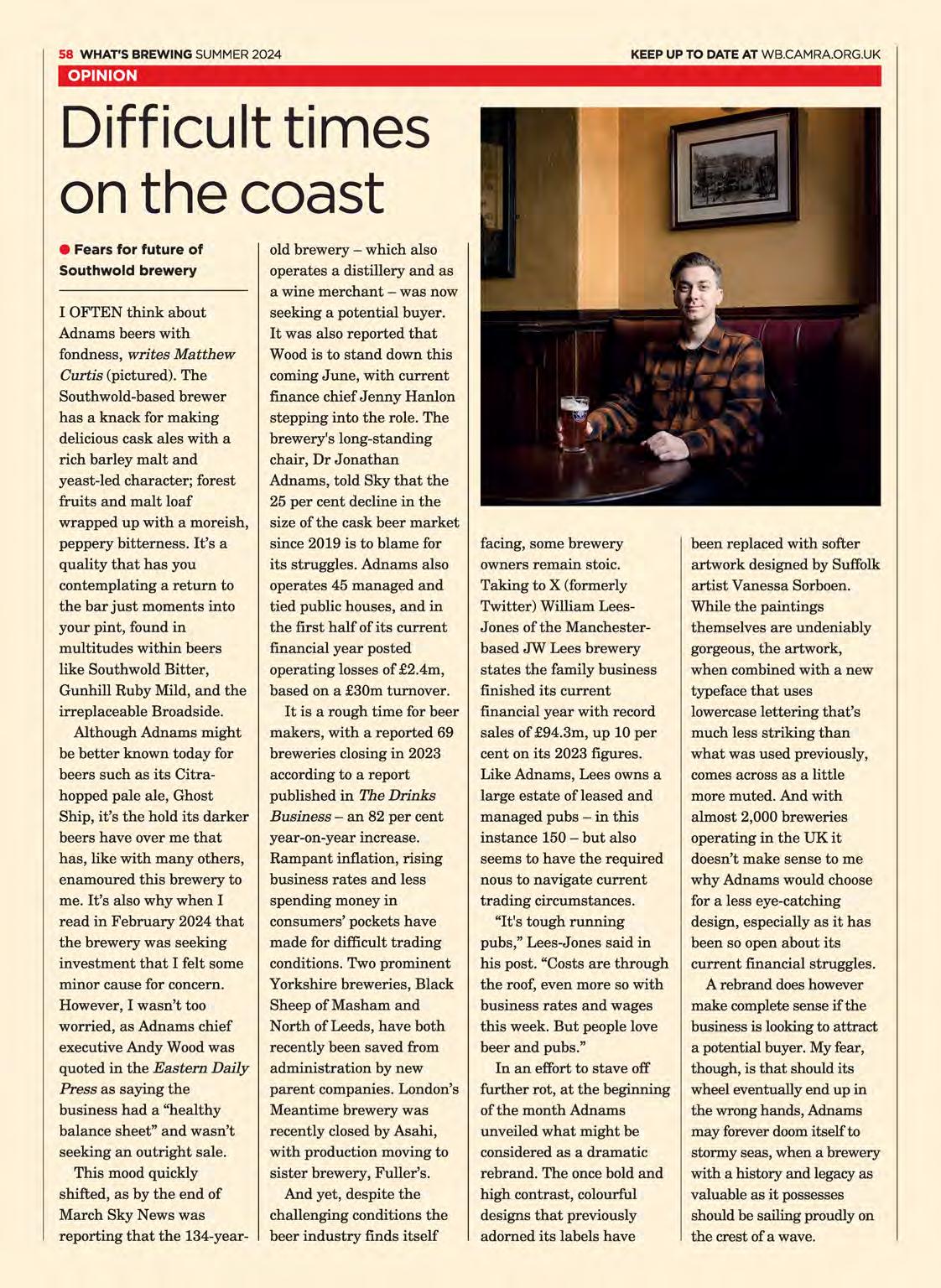
been replaced with softer artwork designed by Suffolk artist Vanessa Sorboen. While the paintings themselves are undeniably gorgeous, the artwork, when combined with a new typeface that uses lowercase lettering that's much less striking than what was used previously, comes across as a little more muted. And with almost 2,000 breweries operating in the UK it doesn't make sense to me why Adnams would choose for a less eye-catching design, especially as it has been so open about its current financial struggles.
A rebrand does however make complete sense if the business is looking to attract a potential buyer. My fear, though, is that should its wheel eventually end up in the wrong hands, Adnams may forever doom itself to stormy seas, when a brewery with a history and legacy as valuable as it possesses should be sailing proudly on the crest of a wave.

